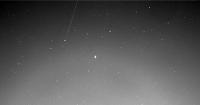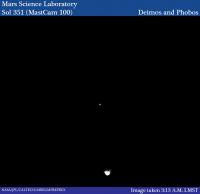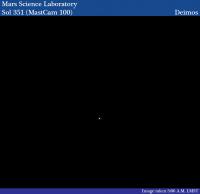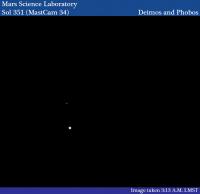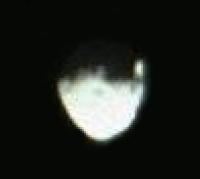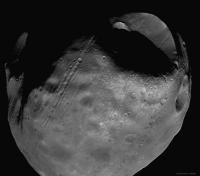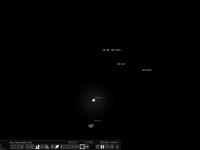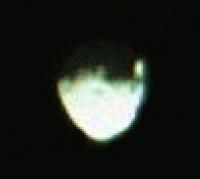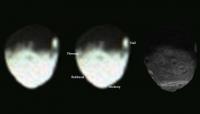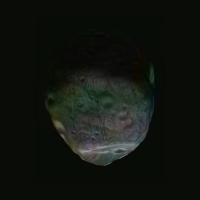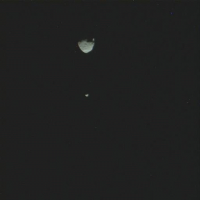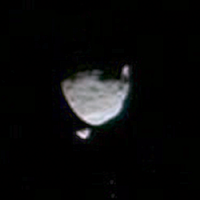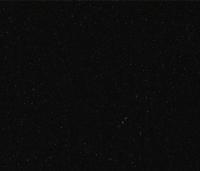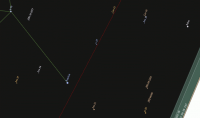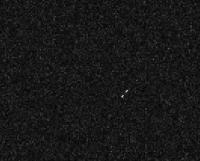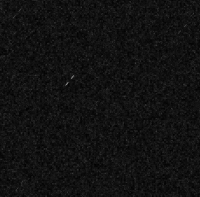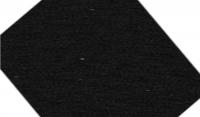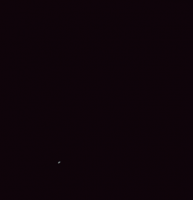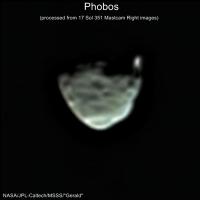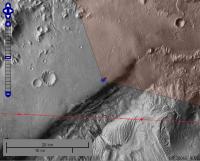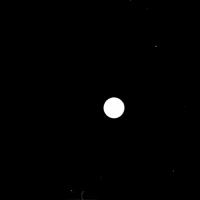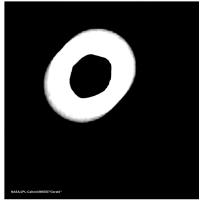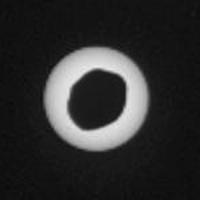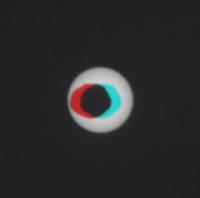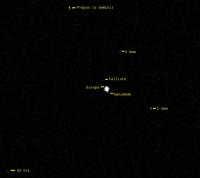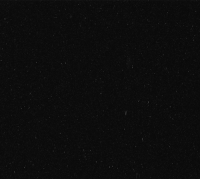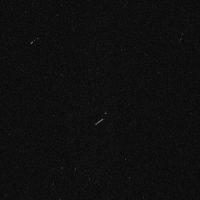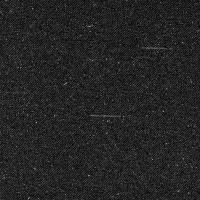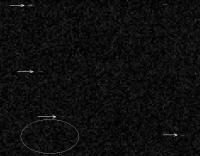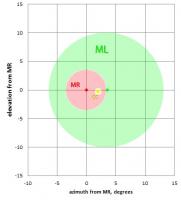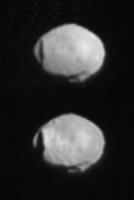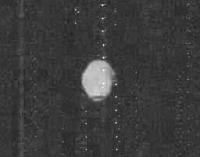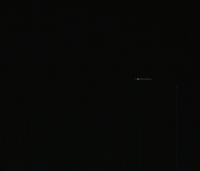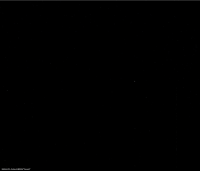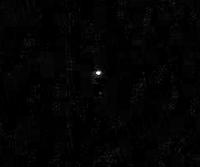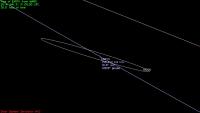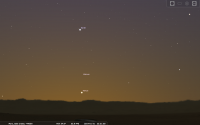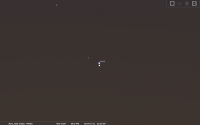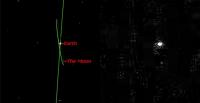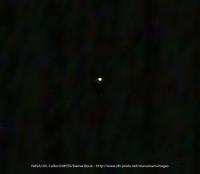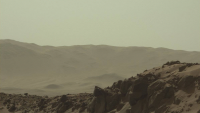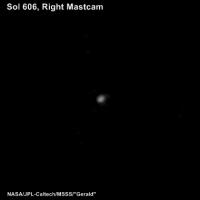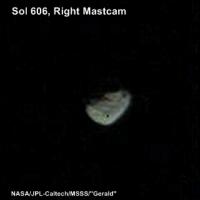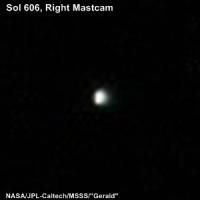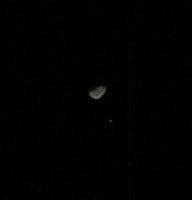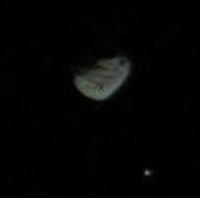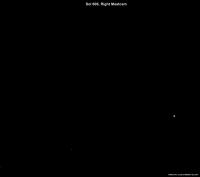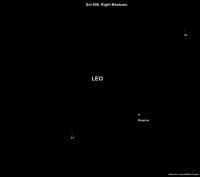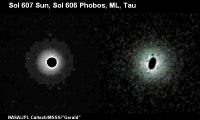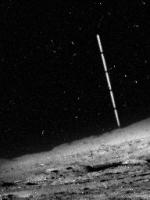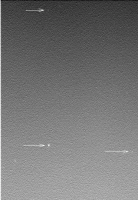Printable Version of Topic
Click here to view this topic in its original format
Unmanned Spaceflight.com _ MSL _ MSL - Astronomical Observations
Posted by: fredk Jun 29 2013, 05:25 PM
What's rising?
http://mars.jpl.nasa.gov/msl-raw-images/proj/msl/redops/ods/surface/sol/00317/opgs/edr/ncam/NRB_425658530EDR_M0060804NCAM00545M_.JPG
Posted by: Zelenyikot Jun 29 2013, 05:37 PM
Phobos in martian sky
http://www.youtube.com/watch?v=9QaQ6TCWq-0
Posted by: iMPREPREX Jun 29 2013, 07:05 PM
http://www.youtube.com/watch?v=9QaQ6TCWq-0
That's awesome. I was wondering what that was! On my take of it, I enhanced the contrast and a haze can be seen. Is that indeed the atmosphere?
Posted by: Zelenyikot Jun 29 2013, 07:41 PM
http://mars.jpl.nasa.gov/msl-raw-images/proj/msl/redops/ods/surface/sol/00317/opgs/edr/ncam/NRB_425658530EDR_M0060804NCAM00545M_.JPG
That line may it be a spacecraft?
Posted by: djellison Jun 29 2013, 11:59 PM
That's a cosmic ray hit.
Posted by: Greenish Jul 1 2013, 05:36 PM
I subtracted the median of all frames and enhanced the contrast. I don't know enough to interpret it for sure, but it sure looks like very well defined clouds drifting by.
http://www.youtube.com/watch?v=AFa27WtnFHI
(if you watch in HD it has the full resolution of the original 511x511 images, although there are some compression artifacts).
Posted by: Gerald Aug 3 2013, 12:09 AM
Sol 351 Mastcam Right thumbnail time-lapse (magnified from 64x64 to 128x128):
http://imgbox.com/adlB02in
Deimos or Phobos?
Posted by: Zelenyikot Aug 3 2013, 12:22 AM
Transit of Phobos across Deimos
Posted by: Gerald Aug 3 2013, 01:04 AM
Thank you very much, Zelenyikot!
The enhanced two-image gif
(based on NASA/JPL-Caltech/MSSS) makes things more obvious.
Posted by: iMPREPREX Aug 3 2013, 10:34 AM
Wow! A few full resolution images of Deimos and Phobos have come in. Here's my take at taking out the noise and leaving the moons. ![]()
Edited to add two more: a Mastcam 34 shot and a MastCam 100 shot of Phobos.
Posted by: wildespace Aug 3 2013, 11:23 AM
I think I'm seeing the large Stickney crater, and possibly Reldresal crater too. What Phobos features can you see here?
Posted by: iMPREPREX Aug 3 2013, 11:32 AM
That most certainly, to me, looks like the Stickney crater. Man, that's awesome. Good looking out. ![]()
Posted by: wildespace Aug 3 2013, 12:23 PM
Here's a Stellarium screenshot, set for the place, time, and the approximate field of view of the Mastcam shot. Some of the brighter stars are indicated, I wonder if image-processing wizards here can bring them out in the Mastcam shots. ![]()
http://www.pictureshack.us/images/87310_phobosdeimos2.jpg
Also of interest may be the saturation-enhanced closeup of Phobos. I wonder is these colours are due to how Mastcam processed the image, or are they the real subtle colour variations of the surface.
Posted by: Phil Stooke Aug 3 2013, 12:59 PM
Sorry folks, I think you have your Phobos geography all tangled up. The clearly visible crater is Hall at the south pole, north is at left, Stickney is at the bottom, essentially invisible because the sun is shining straight into it. I will post a comparison image later when I can get to it. (turn that Viking image 180 degrees for an idea of what you're seeing, except the illumination is different)
Phil
Posted by: iMPREPREX Aug 3 2013, 01:09 PM
I trust and believe your words, Phil. But to me it did look like it could be Stickney in the image. I'm looking forward to seeing the comparison image because I couldn't find anything on Google. ![]()
Posted by: Phil Stooke Aug 3 2013, 03:40 PM
Here's a comparison - the map image is from here:
http://www.solarviews.com/cap/mars/phobos6.htm
(the image which Tayfun projected onto the shape model originated from USGS as the caption says, but it is the one which I had previously reprojected into modern coordinates. The USGS version was based on an experimental shape model and was badly distorted. I reprojected it cell by cell to fit Damon Simonelli's shape model from Cornell)
Hall crater is visible at the bottom. Kepler Dorsum runs horizontally just above it.
Phil
Posted by: iMPREPREX Aug 3 2013, 03:51 PM
That's an incredible eye you have, Phil. Thank you and sorry. ![]() To the untrained eye though, you have to agree that it could be mistaken for the Stickney.
To the untrained eye though, you have to agree that it could be mistaken for the Stickney.
Posted by: Zelenyikot Aug 3 2013, 03:57 PM
Any big crater on the Phobos is Stickney
Posted by: elakdawalla Aug 3 2013, 04:16 PM
Remember that Phobos is synchronously rotating, just like our moon, and Stickey faces more-or-less forward along the orbit, so it's always going to be closer to the limb than to the center of the disk.
A corollary to that is that any spacecraft that either sits on the surface or is in a low, circular mapping orbit (MGS, ODY, MRO) will always only see the Mars-facing hemisphere of Phobos. Only Mars Express and earlier spacecraft have seen other sides.
Posted by: ugordan Aug 3 2013, 05:08 PM
There's also what appears to be faint "mars-shine" illuminating Phobos if you play with image brightness:
Do we expect the original raw data to be overexposed, because the thumbnails kind of give the impression that the images are well-exposed?
EDIT: Ahh, I see now. That one full-res image corresponds to an overexposed thumbnail as well. Other shots should look pretty spectacular, then.
Posted by: mcaplinger Aug 3 2013, 05:17 PM
The full-res image you're looking at is from sequence 1424 and the better-exposed thumbnails from sequence 1423, which presumably have different exposure times.
Posted by: wildespace Aug 5 2013, 09:05 AM
Zelenyikot's images of Phobos gave me an idea to overlay colour information from the Mastcam image onto the detailed Celestia image:
For aesthtetic purpose, if anything, but I do hope to hear whether the Mastcam really picked those colours, or whether they're just an artifact.
Posted by: Phil Stooke Aug 5 2013, 11:49 AM
I'm sorry to say they are artifacts. There are very subtle colour variations on Phobos but not like those.
Phil
Posted by: Phil Stooke Aug 6 2013, 01:44 PM
This is a super-resolution composite of five frames from the Phobos-Deimos sequence on sol 351. Four images (in two pairs) of Deimos appear as smudges on each side - one of them shows the position of the dark limb of Phobos. The 'super-resolution' process (combining multiple views, enlarged and sharpened) is mostly just reducing the JPG artifacts here. Now Stickney can be seen at left, where it was overexposed before.
Phil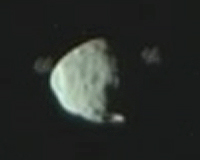
PS - I don't show it here, but if you increase the saturation in the RGB image you see some color variation - this is real color variation on Phobos, blue around Stickney, red over the northern limb. I say 'real color variation' - not 'true color'!
Posted by: ugordan Aug 6 2013, 04:10 PM
A few frames registered on Deimos and a few frames registered on Phobos stacked and merged. Magnified 2x, sharpened and white-balanced.
Posted by: atomoid Aug 6 2013, 09:21 PM
very nice indeed, this actually poses an interesting puzzle. So this is perhaps looking at the eastern horizon before solrise with Phobos soon to set. And it looks like Deimos is going retrograde against the background of stars and that must be due to a parallax effect of the MSL observation point sweeping underneath and overtaking Deimos' actual slower motion in the same direction as Phobos..?
hoping for a m100 transit if the cam can take it, hopefully in the right place to get one as good http://marsrovers.jpl.nasa.gov/gallery/all/1/p/047/1P132370921ESF05AMP2672R8M1.HTML. Colors come out in http://hirise.lpl.arizona.edu/phobos.php..
Posted by: jmknapp Aug 7 2013, 12:10 AM
The moons are so tiny, I've wondered if they'd be much to look at "in person," but based on these images it looks to be a very striking sight.
BTW, the NY Times tracking map now pretty much matches the official.
Posted by: mcaplinger Aug 7 2013, 12:46 AM
hoping for a m100 transit if the cam can take it...
Deimos moves E-W and Phobos moves W-E because of the rotation of Mars, so I'm not sure what your retrograde reference is to.
If you didn't like the grazing observations last year, there are more chances coming up later in the month. http://meetingorganizer.copernicus.org/EPSC2012/EPSC2012-326.pdf
Posted by: paraisosdelsistemasolar Aug 7 2013, 05:25 PM
It seems Curiosity taken some pics with different exposure times at the sky during the Sol 351:
From the pointing data... could it be Regulus?
Posted by: fredk Aug 7 2013, 06:28 PM
Regulus looks good. To bring out the fainter stars, I subtracted two ML frames, took the absolute value, and then did a linear contrast stretch. That supresses noise ("fake stars") and any real stars are visible as pairs of points, with the same separation distance and orientation for all real stars. I then generated a chart of the Regulus region at the same scale as ML (15 degrees per 1200 pix). The scale was set by hand so isn't exact. I then adjusted the one free parameter (overall orientation) until I found a match.
Here's an animation flipping between the chart and the ML difference image. There are two or three stars visible apart from Regulus (circled in the ML frame). The scale's out a bit but the fit is otherwise very good, considering there is only one free parameter here:
The stars apart from Regulus are Leo eta-30, Subra, and possibly Leo 31.
And here's a similar difference of two MR frames. You can see a few real stars (paired streaks, same orientation and separation). These stars are too faint to show up on my chart...
Crazy that Regulus is very close to the Sun now as seen from Earth, so we'd normally never see it this time of year.
Posted by: fredk Aug 7 2013, 07:05 PM
Update to the Leo pics with one new ML frame. Now the stars are more obvious. All three previous candidates confirmed, and one new star, Leo rho-47, also spotted right where it should be:
Posted by: paraisosdelsistemasolar Aug 7 2013, 07:05 PM
With the MastCam Left frames and with the advice of Fredk I made a new version of the star frames taken during Sol 351:
Posted by: fredk Aug 7 2013, 11:23 PM
Here's a much improved attempt at extracting stars from the sol 351 ML frames. This time I took the two (positive-valued) differences of the two frames, carefully registered them (which entailed correcting for a bit of frame rotation between the two frames), averaged them, and then applied a filter with a kernel tailored to the star streaks (19 pix wide, 1 pix high). These steps were interspersed with various contrast stretches along the way.
The result now starts to look like an image of the night sky, with many stars visible. But the faintest stars I can see are only around magnitude 5.5 or 6, so they would be quite easy naked eye from a dark site. We know that mastcam was not designed to image the night sky!
It's also interesting to note that the direction of star trailing is not very different from what it would be near Regulus as seen from Earth, even though the celestial poles of Mars and Earth are quite far apart. This is because the two poles are roughly in a straight line (geodesic) with Regulus.
Posted by: atomoid Aug 8 2013, 12:30 AM
Relative to the background of stars (not horizon), both moons should be moving in the same direction. However, http://www.unmannedspaceflight.com/index.php?act=attach&type=post&id=30673 and the source files show apparent retrograde motion of Deimos relative to those stars. The time span of the sequence is only about 2 minutes which works out to something like 30 miles which doesnt seem enough for any sort of parallax effect. http://curiosityrover.com/imgpoint.php?name=0351MR1423000545M1_DXXX says camera bearing 80.39° (E), elevation 58.64° so they arent even at zenith to mazimize that effect, I tried out a quick sim in Stellarium based on the http://tools.wmflabs.org/geohack/geohack.php?pagename=Bradbury_Landing¶ms=4.5895_S_137.4417_E_globe:Mars and one of the stars in the pair above could be HIP53525 with the lone one below perhaps HIP54084. But maybe these apparent 'stars' are dead pixel artifacts fixed on the frame that are masquerading as stars so there's really no apparent retrograde motion of Deimos (or perhaps most likely ive just lost my mind)
and thanks for the grazing schedule link, http://www.midnightplanets.com/web/MSL/image/00037/0037MR0211000014D1_DXXX.html you http://www.midnightplanets.com/web/MSL/image/00042/0042MR0183011101K0_DXXX.html are away on vacation, looking forward to next week!
Posted by: mcaplinger Aug 8 2013, 12:47 AM
Yes, almost certainly. Remember that exposing for the Moon/a moon is like exposing for any other (admittedly dark) sunlit object, so these exposure times were fairly short.
Posted by: iMPREPREX Aug 8 2013, 01:38 AM
We're getting there with the moon shots!
Posted by: atomoid Aug 8 2013, 02:34 AM
It looks like we might eventually get the full sweep between 3:02 and 3:04
So these must be stars in the http://www.midnightplanets.com/web/MSL/image/00351/0351MR1422000000E1_DXXX.html centering on Deimos.
Then after the close in exposure optimized shots of the transit, we pull back out with long exposure and see the stars again in the http://www.midnightplanets.com/web/MSL/image/00351/0351MR1424001000E1_DXXX.html
The stars in the long exposure shots appear to correspond perfectly with the stars in the subframe transit shots, so it appears Deimos is going the opposite direction as Phobos relative to the background stars!
Posted by: Deimos Aug 8 2013, 04:29 AM
Deimos and Phobos both orbit in the same direction, as you know. Deimos is far enough out that it (like our moon) has an orbital period longer than the planets rotational period, and its apparent motion is in the same sense as the stars. But it lags them, and does not change directions with respect to the horizon or the stars. Remember, Deimos is moving many times faster than the rover in an inertial, Mars-centered frame. Phobos is closer and faster, so it crosses the sky in the opposite direction, but just moves faster in the same direction with respect to the stars. So if they appear to move in opposite directions with respect to something, I would speculate the 'something' is not a star. Warm/hot pixels tend to be much more observable than stars for cameras optimized for landscape photos.
Posted by: fredk Aug 8 2013, 04:44 AM
Adding to Deimos's comments, both those MR frames you pointed to (and all the MR frames from that sequence) have the same bearing/elevation, as Joe's site shows, so they're pointing at a fixed direction in the sky, not following the stars. But the frames are minutes apart. Stars would have moved many pixels between the frames. So those are all hot pixels.
Stars are pretty hard to see with mastcam. Compare the raw Regulus shots with my heavily processed ones - how many stars can you see on the raw shots? And with short enough exposures that the stars wouldn't trail, it would be extremely hard.
Posted by: atomoid Aug 9 2013, 01:36 AM
So many hot pixels, some even masquerading as star streaks but in the wrong direction (not sure if hot pixels explains those as they should be stationary in the frame) and the only star (Regulus, as Zelenyikot points out) in these shots is the the streak going lower left http://mars.jpl.nasa.gov/msl-raw-images/msss/00351/mcam/0351MR1425004000E1_DXXX.jpg to upper right http://mars.jpl.nasa.gov/msl-raw-images/msss/00351/mcam/0351MR1425005000E1_DXXX.jpg (though its possible to notice a couple other extremely faint ones in similar motion).
gotta love those hot pixels though, http://mars.jpl.nasa.gov/msl-raw-images/msss/00351/mcam/0351ML1424001000E1_DXXX.jpg.
Posted by: Deimos Aug 9 2013, 02:05 AM
The hot pixels that streak in the wrong direction are bleeding down columns due to saturation. That is intrinsically colorful on a Bayer-pattern-microfilter CCD, though bland or uneven on a non-patterned CCD. The Regulus images are aimed a bit differently, so any star streaks would be somewhat different, but not column-oriented.
Posted by: Gerald Aug 10 2013, 10:37 AM
The 17 Sol 351 Mastcam Right Phobos images available by now can be processed in a way to get a glance at the dark side of Phobos: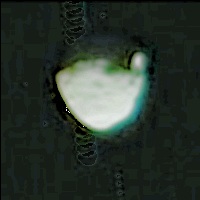
Processing roughly sketched:
- Calculating with double precision floating point rgb values,
- magnifying twice, interpolating subpixels,
- registering images to Phobos, iteratively by brightness barycenter of shrinking region (reducing Deimos effect), then by least squares of image deltas.
- averaging each pixel pos over main mode (accepting 20/256 delta from average) of all frames to filter out Deimos, stars, artifacts, and to reduce noise,
- subtracting background (estimated to 27/256 grey value),
- using logarithm to get bright and dark colors within 8-bit rgb range,
- additional manual stretching (brightness, saturation).
Some chromatic aberration seems to get visible this way.
Some processing artifacts (bright pixels) seem to be induced by (undefined) logarithm of 0 for pixels below 27/256, can be fixed.
I've been trying to suggest, that long exposure times can be simulated successfully by registered image sequences, and that motion blur can be limited at the same time.
So I'm optimistic, that comet observations will become possible.
Posted by: iMPREPREX Aug 10 2013, 11:23 AM
Very nice. You've inspired me to take a crack at it (I'm more focusing on the detail on the bright side). ![]()

Full size: http://www.flickr.com/photos/84750994@N05/9476254849/sizes/o/
Blown up 400%. ![]()
Posted by: Gerald Aug 10 2013, 07:45 PM
Astonishing results!
I couldn't get much beyond this for the bright side (Sol 351 MR, 17 images):
... Beautiful panos, Damia!
Posted by: Zelenyikot Aug 11 2013, 07:06 PM
Phobos and Deimos dance ![]()
http://www.youtube.com/watch?v=7abQLDeD0xM
Posted by: Gerald Aug 15 2013, 06:00 PM
Sol 363 Phobos transit with available 96x96 thumbnails rather subtle yet, despite 2x magnifying and sharpening:
Hoping for full version, soon.
Posted by: Gerald Aug 16 2013, 03:02 AM
The Sol 351 Phobos/Deimos sequence is almost complete now:
http://imgbox.com/abmfkz7c
Images are roughly registered to Phobos and sharpened.
Posted by: Phil Stooke Aug 16 2013, 03:18 PM
Revisiting the Phobos images:
http://mars.jpl.nasa.gov/msl/multimedia/images/?ImageID=5511
This is a very nice comparison of the apparent sizes of Phobos, Deimos and our Moon seen from their respective planets... but check the caption:
"The size-comparison image of Earth's moon, on the right, is also oriented with north up."
Sorry, JPL buddies, but not so - this looks like a distant Galileo encounter 2 image, and the north pole is at right, pretty much at the middle of the terminator - it's almost looking down on the pole.
Phil
Posted by: wildespace Aug 16 2013, 05:28 PM
Interesting, the image shows that Phobos is approx as wide as the Moon in the widest part, and half as wide in the short part. Stellarium shows a much smaller Phobos as seen from Mars, 0.125 degrees or approx 1/4th of the Moon diameter, but perhaps Stellarium is not the most precise software in that regard. What is Phobos' angular size as shown in Celestia?
P.S. I plugged the numbers from the JPL link into an online calculator at http://www.1728.org/angsize.htm and the result is 0.2 degrees, slightly less than half the full moon.
Posted by: fredk Aug 16 2013, 06:11 PM
Phobos orbits so low that its angular size varies substantially depending on how far above the horizon it is - from something like 0.14 degree at the horizon to 0.2 degree at zenith. (I'm not sure if that corresponds to an average diameter or what.)
The press image doesn't show the long axis of Phobos as wide as the moon (0.5 degrees). Look at the Marsshine images and you'll see that most (about 2/3 or 3/4) of the length of Phobos is in sunlight in this image. So it shows the long axis at roughly 0.3 degrees wide.
Posted by: Deimos Aug 16 2013, 09:08 PM
I wonder how this happened?
http://mars.jpl.nasa.gov/msl/multimedia/images/?ImageID=5511
Thanks to Phil Stooke, wildespace, fredk (and Doug E). Note that the image of Phobos and Deimos that is used is enlarged to 2x MCAM-100 resolution. That has a 5 deg field of view spanned by 1200 pixels. The roughly N-S axis of Phobos is, in fact, nearly 0.2 deg in the image.
Posted by: djellison Aug 16 2013, 10:26 PM
Ahh - just saw Marc's post
Yeah - whacked out a little render of the moon to fit the job
https://solarsystem.nasa.gov/multimedia/display.cfm?Category=Planets&IM_ID=17749
Doug
Posted by: stevesliva Aug 17 2013, 05:28 AM
[Moon] Atlas did not shrug.
Posted by: Gerald Aug 20 2013, 08:30 AM
The first reasonably resolved Sol 363 Phobos transit (eclipse) images are available, e.g. http://mars.jpl.nasa.gov/msl-raw-images/msss/00363/mcam/0363MR1472000023K0_DXXX.jpg and http://mars.jpl.nasa.gov/msl-raw-images/msss/00363/mcam/0363MR1472000043K0_DXXX.jpg.
Enhanced regions (blur with radius 0.3, brightness stretched):
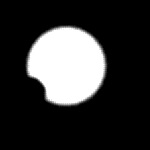
Posted by: fredk Aug 20 2013, 03:24 PM
We caught what appears to be a serious wind gust on sol 368. Notice how the near foreground darkens in the first frame, then the distant slope darkens, before everything brightens up again. That suggests a huge dusty gust blowing roughly north to south. It has to be huge to darken such a large region. This is half-resolution, to fit all frames into 1MB:
Posted by: fredk Aug 20 2013, 03:44 PM
Full resolution view of the big gust, cropped and including only the first four frames to fit (there is very little change after the fourth frame):
Posted by: Gerald Aug 20 2013, 08:20 PM
If you are right, this may be the first successful triggering of a Hazcam sequence by a REMS event.
Great observation!
It may look large, as it probably moved straight over MSL.
Posted by: fredk Aug 20 2013, 08:42 PM
I didn't realize they could trigger from REMS. Very cool. It is hard to say how large it is. All we have to go on is that the entire visible slope of the central mound darkens in frame 2, including the little peak way off to the left. But the visible local horizon doesn't darken noticably. So the dust must be beyond the local horizon, which, given the extent of the darkening, suggests it is very large. Presumably from the timing and some estimate of wind speed we could get an estimate of the size.
Ed - I can't see any way this could be exposure variations. Between the first two frames, eg, the central mound darkens while the foreground stays about the same brightness. Exposure variations would brighten/darken everything uniformly, or maybe in some nonlinear way accounting for lut's and stretching. But whatever the details, all pixels with some particular pixel value must be mapped to the same pixel value after the exposure change (if the scene remains the same, of course). You shouldn't see some parts of the frame with some shade of grey mapped to different shades of grey than other parts with the same original shade of grey.
I'd add one more change to Ed's list. For the first two frames, the sky is brighter than in the other frames. This is all consistent with a gust passing over. The extra dust in the gust would brighten the sky as it passes over, while shading the ground.
Posted by: Gerald Aug 20 2013, 10:57 PM
Similar effects can also be obtained by color filtering.
As example, http://mars.jpl.nasa.gov/msl-raw-images/msss/00364/mcam/0364ML1481020000E1_DXXX.jpg, http://makeagif.com/V1Jl2j, brightness adjusted.
A local dust cloud may work like a color filter, brightness adjustment by exposure time.
Posted by: dvandorn Aug 20 2013, 11:37 PM
Must it have been a dust cloud? The air at Gale has been getting clearer and less dusty lately, I thought.
What are the possibilities of either clouds or one of the larger-size dust devils casting these shadows?
-the other Doug
Posted by: Deimos Aug 21 2013, 12:17 AM
REMS cannot currently be used to trigger imaging. The general idea does go way back, but I don't know of any MSL related implementation. Any other images document the event time frame?
Posted by: PaulH51 Aug 21 2013, 12:18 AM
Could this 'event' have been caused by the transit of Phobos? By reducing the light level (when the darkened HazCam was captured) or by the reduced lighting causing an abrupt fluctuation in the air temperature?
Note: the MastCam 100 was taking a sequence of images of such a transit at the same time as the 'event'. http://www.midnightplanets.com/web/MSL/sol/00368.html
Posted by: dvandorn Aug 21 2013, 12:25 AM
Are you saying that we could have been seeing the shadow of Phobos passing over the terrain?
Cooool!!!
-the other Doug
Posted by: Gerald Aug 21 2013, 12:25 AM
First, for a better illustration of the filtering effect of an assumed dd-related local dust cloud, I've combined an rgb image from two Sol 368 grey-scale Rear Hazcam Left B images (red from one image, green and blue from the other, so actually just two color channels) :
Local dust devils don't necessarily increase the overall dust in the atmosphere, as long as there isn't a local or regional dust storm.
Edit: There was again a transit, very convincing explanation, Paul! So it will have been a shadow of Phobos, instead of a dd.
Interesting, that the channel combination did work, nevertheless.
Posted by: elakdawalla Aug 21 2013, 12:41 AM
No, dude, check it out: there was an eclipse, a good one, happening at the same time as those Hazcam images. Super duper cool. Nicely done, @Deimos!
Posted by: fredk Aug 21 2013, 12:49 AM
Yeah, http://mars.jpl.nasa.gov/msl-raw-images/msss/00368/mcam/0368MR1490000045Q1_DXXX.jpg was simultaneous with the RLB sequence. Very cool indeed! Was this never done with MER?
The darkening moving over to the mound makes sense - the shadow (penumbra) of Phobos is on the order of the size of Phobos, ie 20-odd km. (Actually the penumbra will be somewhat wider.) The mound is several km away.
Posted by: Explorer1 Aug 21 2013, 12:56 AM
Chalk up another amazing one for the team; feels like Spirit and the dust devils all over again!
Next August is another season of transits; by then Curiosity could be on Mount Sharp itself and right in the path... a chance for MAHLI movies?
Posted by: jmknapp Aug 21 2013, 01:37 AM
Cooool!!!
Per SPICE, here's the ground track of the center of Phobos' shadow (red line) during the transit:
The two red dots are the position at the time of two of the HAZCAM shots. The wedge shows the field of view of the rear HAZCAM.
How wide would the shadow be?
Posted by: EdTruthan Aug 21 2013, 02:34 AM
The eclipse thumbnails appear to indicate a maximum conjunction at almost precisely the 03:22:00 P.M. LMST mark, the exact time of the RLB darkening event. Way cool catch by the imaging team.
And speaking of cool - Sol 369 tracks anaglyph - gotta love that repeated JPL Morse Code track. Easy to judge distance too, I believe it's about 1.5 meters per rotation if I'm not mistaken. (50cm wheel diameter x 3.14 = 157cm or 1.57 meters).
http://www.edtruthan.com/mars/Sol369-Navcam-Rover-Tracks-Anaglyph.jpg
Posted by: atomoid Aug 21 2013, 03:02 AM
scroll down to get an idea about the http://en.wikipedia.org/wiki/Transit_of_Phobos_from_Mars, i had no idea it was imaged by Viking lander/orbiter as well! stunning!
hopefully more pics will stream in, i suppose there are more hazcam frames and they werent clustered at the very end of the transit http://www.midnightplanets.com/web/MSL/sol/00368.html. with everything else going on im wondering if it wass technically feasible to stage a navcam sequence as well?
Posted by: Deimos Aug 21 2013, 03:09 AM
MER never imaged the ground while imaging a transit. Partly, this is the sheer scale of the event--maybe 60 km diameter, but no sharp edges. Partly it is that there is not a straight line from the science requirements to taking those images. Once in a while, maybe you do something just because you can. There didn't look like a good chance at Endeavor this year, but in principle right Pancam images can be taken in parallel with left RHAZ or FHAZ. You could do the same with NAV, but of course you couldn't point away from the Sun while also imaging the transit. And the sequencing on MER for that seems complex, given the hoops we jump through to get 3 sec/image out of Pancam.
Maybe next year hazcam could be kicked off earlier in the video. There are sequencing constraints, but boundaries aren't usually pushed hard the first time.
You could consider Navcam of a near-miss transit -- but of course the event center is >30 km away. That's a tough sell given the implications of the specific transit timing constraints on sequencing a sol. That's especially true with Opportunity's power limitations, but transits (and near-misses) don't wait for drives or comm passes ... and are less important than either, in general.
Posted by: Gerald Aug 21 2013, 03:19 AM
"How wide would the shadow be?"
There is no umbra of Phobos on the Martian surface.
The size of Phobos is 26,8 × 22,4 × 18,4 km, average 22.2 km, distance from the surface 6,000 km.
Diameter of the Sun 1,392,684 km, average distance Sun-Mars 228 million km.
Apparent diameter of Phobos relative to Sun therefore (22.2/6,000) / (1.4/228)=0.61.
Therefore the antumbra will be about 14.2 km (remaining 39% of Sun's apparent diameter).
The whole penumbra adds a tiny bit more than the diameter of Phobos around the antumbra, i.e. 22.2 km, together 14.2 + 2 * 22.2 = 58.6 km.
That's a rough approximation based on average values at noon.
The eclipse was in the afternoon, so we get a roughly elliptical shadow, with the apparent diameter of Phobos a little smaller. Irregular shape of Phobos is to be added.
See also http://en.wikipedia.org/wiki/Transit_of_Phobos_from_Mars,
http://en.wikipedia.org/wiki/Phobos_(moon), http://en.wikipedia.org/wiki/Sun, http://www.universetoday.com/14822/how-far-is-mars-from-the-sun/.
Posted by: fredk Aug 21 2013, 04:34 AM
Thanks for the info, Deimos. I see now that what I was thinking of was that we fantasized about this years ago with MER - see http://www.unmannedspaceflight.com/index.php?s=&showtopic=2064&view=findpost&p=36880 and http://www.unmannedspaceflight.com/index.php?s=&showtopic=2064&view=findpost&p=37557 We talked about how cool it would've been to do this from the top of Husband Hill. Maybe we'll get another chance from Oppy or MSL showing the shadow racing across the landscape from a high vantage point...
Posted by: vikingmars Aug 21 2013, 06:27 AM
No with MER, but yes with Viking Lander 1.
Here is the image taken ("rescan" mode) on its mission Sol 423 : the darkening of the Phobos shadow flying above its Chryse Planitia site can be seen easily also. Cheers !

Posted by: Gerald Aug 21 2013, 10:40 AM
In the meanwhile, six of the Sol 363 MR eclipse images are there. Here a 10x time-lapsed gif:
(based on NASA/JPL-Caltech/MSSS)
Well, the Sol 368 eclipse will be much cooler, as Emily pointed out.
Posted by: fredk Aug 21 2013, 03:05 PM
The sol 369 transit looks not bad too - in fact, it looks very close to central:
http://mars.jpl.nasa.gov/msl-raw-images/msss/00369/mcam/0369MR1502000784Q1_DXXX.jpg
Posted by: Gerald Aug 21 2013, 04:36 PM
Bullseye! ![]()
Posted by: fredk Aug 21 2013, 10:25 PM
Here's what I dreamed of doing 7 years ago - I've subtracted the average of the 8 post-transit RLB hazcam frames from each transit frame, then added 128 and did a small symmetrical stretch. So neutral grey means the same as after the transit, dark grey means darker, and light grey lighter than after transit:
As the transit ends, everything goes to neutral grey, with the last bit of shadow fading off into the east. The sky looks brighter during the transit (first two frames) than after, which can't be true of course. So what's probably happening is that different exposures, or more likely just different auto-stretching, are being applied. We'll have to wait for PDS (or a press release) to see how much the sky darkened during the transit...
Posted by: mcaplinger Aug 22 2013, 12:38 AM
All we had to do was get the sun in the field of view at the right time, Phobos did the rest.
Posted by: elakdawalla Aug 22 2013, 02:03 AM
Point a camera with a 5-degree FOV at a moving speck crossing a moving spot from a rover that was only briefly paused in the middle of DRIVING ACROSS ANOTHER FREAKING PLANET??? Pshaw, that's nothing ![]()
Posted by: PaulH51 Aug 22 2013, 02:28 AM
Hats off to the team
Posted by: DeanM Aug 22 2013, 09:04 AM
Quoting Emily: "Point a camera with a 5-degree FOV at a moving speck crossing a moving spot from a rover that was only briefly paused.."
This can have been no easy feat!
Indeed, how is such precise 'pointing' achieved: gravity provides one vector but Mars (now) has no magnetic field to provide a second.
Dean
Posted by: Gerald Aug 22 2013, 09:47 AM
A http://en.wikipedia.org/wiki/Gyroscope could do the job.
Posted by: Deimos Aug 22 2013, 02:16 PM
Sun images show the Sun's position and (optionally) direction of motion in the rover's frame. These allow a full attitude solution or a yaw-only solution. Initial measurement units (gyro-based) update attitude between sun images. MER used a subset of Pancam Sun images. MSL uses Navcam Sun+sky images. The IMU propagates attitude forward, but error builds with drive-time. So the attitude, especially for Sun aims, is precise after a Sun update and before the next drive, and degrades until the next Sun update. The midnight planets page for sol http://www.midnightplanets.com/web/MSL/sol/00369.html shows such an update after the drive (and mid-drive imaging). Sol http://www.midnightplanets.com/web/MERB/sol/03387.html shows an update for Opportunity. (In both cases, look for the Sun image/images after "driving...".)
Posted by: fredk Aug 22 2013, 02:50 PM
I didn't realize that - I had assumed MSL used mastcam. Why navcam? Surely it's harder to pinpoint the sun's position in a navcam frame, or in other words the uncertainty on the sun's position would be much larger in a navcam frame than a mastcam frame. That's both because of the lower resolution of navcam, but also because of the overexposure due to lack of solar filter. (I guess you could pinpoint the position from navcam pretty well in one direction, due to the CCD bleeding.)
Posted by: john_s Aug 22 2013, 03:26 PM
I presume it's simply that Navcam has a much wider field of view, so you can find the sun even if the accumulated error in the rover's orientation is quite large.
John
Posted by: mcaplinger Aug 22 2013, 03:37 PM
On MER they do sun-finding with Pancam, which has the same FOV as the 34mm Mastcam.
It was more a political/requirements-driven issue related to Mastcam being a non-JPL instrument. Mastcam could be used if needed but Navcam is completely sufficient.
Posted by: Gerald Aug 22 2013, 03:55 PM
Here a graphical sketch, how a good reference point can be determined from http://mars.jpl.nasa.gov/msl-raw-images/proj/msl/redops/ods/surface/sol/00369/opgs/edr/ncam/NRB_430259833EDR_F0120982SAPP07612M_.JPG:
http://imgbox.com/adgXKDuy
Posted by: fredk Aug 22 2013, 05:01 PM
But mcaplinger has answered this - the accuracy from navcam is sufficient. One thing I suppose they can do is calibrate - image the sun simultaneously with mastcam and navcam, and use that to create a model for the sun's true position in the navcam overexposed blob. There will still be uncertainties due to differing tau, dust on optics, etc. All of these effects could distort the shape of the overexposed "blob".
Posted by: mcaplinger Aug 22 2013, 05:20 PM
In the accuracy stackup, the uncertainty in the actual RSM pointing from gear backlash, encoder/resolver precision, etc, is probably many times larger than any centroiding error from sun overexposure.
Posted by: Deimos Aug 22 2013, 05:49 PM
I don't know if any flight Mastcam/Navcam tests have been done on the engineering side. I do know that many test images were acquired with the MERs, starting long before MSL's launch. These were used for development and validation, and probably include a decent sampling of atmospheric conditions.
Posted by: Gerald Aug 23 2013, 05:57 PM
Begin and end of the Sol 369 eclipse:
http://imgbox.com/adq8isBy
(magnified 4x by nearest neighbour, blur radius 2, brightness stretched)
They probably downlinked those images first, because they are of highest value for retrieving orbital data (extrapolating the two instants, when Phobos' "disk" is externally tangent to the Sun, compare http://eclipse.gsfc.nasa.gov/OH/transit12.html).
Posted by: Deimos Aug 23 2013, 07:49 PM
Personally, I'd love to have the cool images down fast, and they are of high long term interest as well. But the first and last contacts have a special property that is relevant to planning: they segregate data worth keeping from data that can be deleted. That's the sort of thing one likes to be sure of, and cannot see perfectly in the thumbnails.
Posted by: Gerald Aug 29 2013, 10:46 AM
Phobos silhouette inferred from 3 Sol 369 MR images, so not yet quite free of aliasing and jpg artifacts:
Posted by: Airbag Aug 29 2013, 11:07 AM
What did you do to that image??? http://mars.jpl.nasa.gov/msl-raw-images/msss/00369/mcam/0369MR1502000817L1_DXXX.jpg.
Airbag
Posted by: Gerald Aug 29 2013, 11:40 AM
Squeezing out details which are not visible in a single image. It works better with more images available.
Of course the raw images are great!
Posted by: Phil Stooke Aug 29 2013, 12:56 PM
This is my version of combining the three transit frames, only this time I cropped the solar disk out from two of them.
Phil
Posted by: Gerald Aug 29 2013, 02:30 PM
Good idea! I've been thinking about combining the Sun and Phobos separately, and merging the two resulting images, or else accept the induced motion blur for the Sun. The latter seems to be not too well-favoured. Thanks Airbag, for your feedback!
Here an intermediate animated gif of the 26 Sol 363 eclipse images of "L" type, as far as available by now, not processed:
http://imgbox.com/acqg5Y8U
Posted by: ngunn Aug 29 2013, 03:18 PM
Successive frames from 363 or 369 make good pairs for cross-eye 3D. (I've tried it with paper copies.)
Posted by: Gerald Aug 29 2013, 03:31 PM
Meaning this ?
http://imgbox.com/adny36gg
Edit: Anaglyph:
http://imgbox.com/adx6g9ZL
Yes, another good idea!
Posted by: ngunn Aug 29 2013, 04:29 PM
Thanks for the 3Ds! Since you're onto that so quickly and there are three evenly spaced images in the 369 sequence - how about a two frame 'rocker' movie in 3D ??? ![]()
Posted by: Gerald Aug 29 2013, 04:53 PM
2-frame stereo animated gif of the Sol 369 Phobos transit:
http://makeagif.com/AM51a4
and http://makeagif.com/NCdxHJ.
Sorry for delay! ![]()
Posted by: ngunn Aug 29 2013, 04:55 PM
Fun stuff! Thanks again.
Posted by: fredk Aug 29 2013, 05:20 PM
My cross-eyed version - this one doesn't require anything special to view:
And a parallel-eyed version:
These have an eerie scanning-eyeball look about them...
Posted by: Gerald Aug 29 2013, 05:37 PM
Therefore the name "Phobos". He keeps a scary eye on you. ![]()
Posted by: fredk Aug 31 2013, 03:27 PM
Here's what the mostly-far-side of the sun looked like a couple of weeks ago - this is an average of 8 2x-zoomed and registered MR frames ("poor man's superres") from sol 363, followed by a contrast stretch:
A Phobos transit was just starting and ending in these 8 frames - that explains the shadowy notches at 7 and 10 o'clock. But a couple of sunspots are clearly visible.
Posted by: Gerald Aug 31 2013, 08:40 PM
http://mars.jpl.nasa.gov/msl-raw-images/msss/00363/mcam/0363MR1472000062L1_DXXX.jpg, subframe stretched by histogram, then hipass-filtered with radius 5, result brightness stretched:

Edit: Same with this http://mars.jpl.nasa.gov/msl-raw-images/msss/00368/mcam/0368MR1490000015L1_DXXX.jpg:

to improve evidence, that it's not an artifact. Probable sunspots moved to the right and weakened.
Posted by: jmknapp Sep 2 2013, 12:05 AM
Looks like they did some night sky MR work the other night, e.g.,
http://curiosityrover.com/imgpoint.php?name=0378MR1555000000C0_DXXX
http://mars.jpl.nasa.gov/msl-raw-images/msss/00378/mcam/0378MR1555000000C0_DXXX.jpg
Based on the pointing (267.42° (W), elevation 41.99°) & consulting Stellarium, Jupiter would have been in the frame of this one.
Posted by: paraisosdelsistemasolar Sep 3 2013, 09:23 AM
Just arrived from Mars, the first frames from the Sol 378 Phobos/Deimos sequence:
http://imgur.com/VFhG6HW
Posted by: Gerald Sep 4 2013, 11:17 AM
Sol 369 Phobos transit, sampled with 40ms (time-lapse) and 370ms (close to real-time) per frame (82 frames), there is still a small gap:
http://imgbox.com/abiQKity http://imgbox.com/adphn6Ab
Posted by: Zelenyikot Sep 4 2013, 11:54 AM
Solar eclipse in youtube http://www.youtube.com/watch?v=eQMcppy7PdM
![]()
Posted by: SFJCody Sep 4 2013, 12:56 PM
Anyone know any good, recent, freely accessible papers describing the future orbital evolution of Phobos? Have googled but to no avail. I'm interesting in finding out how many millions of years will elapse before Phobos is capable of producing total rather than annular eclipses.
Edit: found one! Clearly I wasn't googling very well the first time!
Posted by: jmknapp Sep 4 2013, 01:05 PM
Try this:
http://www-geodyn.mit.edu/bills_phobos05.pdf
They put an upper bound of 30-50 million years before Phobos impacts Mars. Lots of uncertainties though.
Posted by: SFJCody Sep 4 2013, 02:11 PM
No, same one. I'll have a look at it this evening (UTC).
Posted by: paraisosdelsistemasolar Sep 6 2013, 10:41 AM
Curiosity taken some Jupiter images during Sol 385. I added two of them with the same exposure (or very similar according to the trails) and later removed the noise:
http://imgur.com/Ukt2DnD
Posted by: Gerald Sep 6 2013, 11:30 AM
Trying to avoid doubling of the objects/hot pixels, streched to the heck:
http://imgbox.com/acdgqoae
Edit:
http://mars.jpl.nasa.gov/msl-raw-images/msss/00385/mcam/0385MR1575000000C0_DXXX.jpg looks a little washed-out in an asymmetric way. Could it be a comet? Here a cleaned version:
http://imgbox.com/abzX0aWA
Posted by: paraisosdelsistemasolar Sep 6 2013, 01:18 PM
Gerald, the picture pointing data says it's also pointing to the same place, but with a lower exposure time or out of focus. So I suppose it must be Jupiter too.
Posted by: Gerald Sep 6 2013, 02:09 PM
Thanks so much! I've been confused due to the pointing argument. So it's probably out of focus, or some other blur.
Posted by: fredk Sep 6 2013, 03:23 PM
Yeah, if you compare these two frames:
http://mars.jpl.nasa.gov/msl-raw-images/msss/00385/mcam/0385MR1575000000C0_DXXX.jpg
http://mars.jpl.nasa.gov/msl-raw-images/msss/00385/mcam/0385MR1575006000C0_DXXX.jpg
one looks more blurred than the other, so it looks like fluctuating focus.
Here's my version of the Jupiter image, with the two differences of the two frames stretched, then registered, then averaged, all to beat the noise down:
And the sol 378 night sky pair processed in the same way:
There are about a half dozen stars visible, but I don't know what part of the sky we're seeing here...
Posted by: ngunn Sep 6 2013, 03:48 PM
Are we also seeing 2 (or 3) moons?
Posted by: dilo Sep 6 2013, 04:20 PM
Yes, as highlighted by Nahum in http://www.unmannedspaceflight.com/index.php?s=&showtopic=7691&view=findpost&p=203010 and re-proposed here with a couple more stars (fredk image with blur + curve modify):
Posted by: ngunn Sep 6 2013, 05:25 PM
Oops - sorry. For some reason I couldn't see the attached image when I originally read that post.
Posted by: James Sorenson Sep 7 2013, 04:23 AM
My take on the Jupiter image. View the original version for the animated GIF.
http://www.flickr.com/photos/43581439@N08/9691280270/sizes/o/in/photostream/
http://www.flickr.com/photos/43581439@N08/9691280270/
An inverted image, hopefully to make things more visible.
http://www.flickr.com/photos/43581439@N08/9691992446/
The field of view based on Joe's NAIF/Spice pointing data in Starry Night.
http://www.flickr.com/photos/43581439@N08/9687485601/
Posted by: fredk Sep 7 2013, 02:34 PM
Check out the new http://mars.jpl.nasa.gov/msl/multimedia/videos/index.cfm?v=144 for a nice composite showing the darkened landscape and sky synched with the mastcam view.
Posted by: fredk Sep 8 2013, 03:16 PM
Sol 387 nightsky imaging, same processing as before:
One bright and some much fainter stars(/planet?) - I don't know what part of the sky we're looking at...
Posted by: Gerald Sep 8 2013, 09:17 PM
Some more filtering (enhancing vertical structures present in both raw images), and more objects (stars?), only visible in http://mars.jpl.nasa.gov/msl-raw-images/msss/00387/mcam/0387MR1586001000C0_DXXX.jpg:
http://imgbox.com/acdYGXEZ
Posted by: udolein Sep 8 2013, 09:48 PM
.gif from both Sol 387 right MastCam Images (click to enlarge):
and the details:
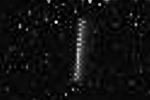
the object seems to blink somehow ...
Cheers, Udo
Posted by: fredk Sep 8 2013, 11:20 PM
By "blink", do you mean the pixel-scale periodic bright-dark pattern along the star trail? Maybe something to do with the CCD Bayer pattern or the CCD readout.
Posted by: James Sorenson Sep 11 2013, 03:51 PM
Phobos and the stars on Sol-387.
Enhanced animated GIF
http://www.flickr.com/photos/43581439@N08/9722843063/sizes/o/in/photostream/
http://www.flickr.com/photos/43581439@N08/9722843063/
Enhanced Inverted animated GIF
http://www.flickr.com/photos/43581439@N08/9722842841/sizes/o/in/photostream/
http://www.flickr.com/photos/43581439@N08/9722842841/
Original images after long exposure hot pixel subtraction, Not enhanced
http://www.flickr.com/photos/43581439@N08/9722843273/sizes/o/in/photostream/
http://www.flickr.com/photos/43581439@N08/9722843273/
Simulated Starry Night View with Joe's NAIF/Spice pointing data.
http://www.flickr.com/photos/43581439@N08/9722843427/
Posted by: fredk Sep 11 2013, 05:59 PM
Could you explain what you did here? Did you subtract some other frame from the two 387 frames to reduce hot pixels? Which frame did you use? Did that frame have Phobos? Why is Phobos in the Starry Night view but not in the two 387 frames?
Posted by: James Sorenson Sep 11 2013, 06:10 PM
What I did is I subtracted one of the two frames that were taken on top of each other and used the subtracted frame kind of as a dark-frame/bias frame to get rid of the long exposure noise. JPEG noise is still there, but I did some jpg noise reduction to lessen that. During enhancement, that however brings that back. Phobos is the blurred object seen, since obviously it a somewhat long exposure image.
Posted by: fredk Sep 11 2013, 06:22 PM
OK, so that sounds like what I've been doing. Thanks for ID'ing the star field, too.
But holy smoke, I had noticed the smudge in those frames but it never occurred to me that that was Phobos. This is extremely cool: Phobos imaged while eclipsed by Mars! I don't recall such an observation from MER...
Posted by: James Sorenson Sep 11 2013, 06:30 PM
![]()
Phobos was captured going into Mars's shadow during an eclipse on Sol-675 by Spirit.
http://marswatch.astro.cornell.edu/pancam_instrument/projects_2.html
Posted by: fredk Sep 11 2013, 06:57 PM
Of course, I remember that MER Phobos eclipse observation now.
Here's my best attempt at recoving Phobos. I took the differences of the two frames, registered them on Phobos (hard to do precisely, since it's so faint), and then averaged to reduce jpeg noise (interspersed with level adjustments):
I've left Aldebaran below for good measure.
This makes me wonder where Phobos is being illuminated from. Presumably it's sunlight scattered through the dusty Martian atmosphere, like the way our Moon is illuminated during a total lunar eclipse. I wonder if it would also appear a dull red colour. The frames we have are ony 8 bit, so we have no colour information.
Posted by: ngunn Sep 11 2013, 07:11 PM
My guess would be bluish, like the colour of a Martian sunset.
Posted by: James Sorenson Sep 11 2013, 07:38 PM
According to Starry Night, those images were taken a few minutes before and after Phobos entered eclipse phase. ![]()
Posted by: fredk Sep 14 2013, 03:05 PM
ML view of Phobos in eclipse, from sol 387. The two frame differences were registered on the ghostly Phobos and averaged.
Phobos is the ghostly smudge above centre, Aldebaran is the star. These frames were full colour, but I don't see any clear sense of hue in Phobos. S/N is just too low.
Posted by: Gerald Sep 14 2013, 08:46 PM
Trying to filter out Phobos, hot pixels, noise, CR, and to enhance stars at the same time:
http://imgbox.com/abenxbXX
That's rather hard with just two images, so not really perfect.
At least the most prominent stars of Taurus became clearly visible (some noise also).
http://makeagif.com/CYEh6e an animated gif of the intermediate steps.
Edit: This is an excessively saturation stretched version of a Sol 387 ML Phobos combined image:
Posted by: James Sorenson Sep 15 2013, 10:00 PM
Phobos, Deimos, and Jupiter in the same image ![]() .
.
Enhanced Full Animated GIF
http://www.flickr.com/photos/43581439@N08/9764557201/sizes/o/in/photostream/
http://www.flickr.com/photos/43581439@N08/9764557201/
Enhanced Inverted Animated GIF
http://www.flickr.com/photos/43581439@N08/9764772484/sizes/o/in/photostream/
http://www.flickr.com/photos/43581439@N08/9764772484/
Starry Night view with Joes NAIF/Spice pointing data
http://www.flickr.com/photos/43581439@N08/9764843063/
The full frames are not available yet for this thumb, but here is a starry night view.
http://mars.jpl.nasa.gov/msl-raw-images/msss/00393/mcam/0393ML1621007000I1_DXXX.jpg
http://www.flickr.com/photos/43581439@N08/9764845683/
Posted by: stevesliva Sep 16 2013, 12:49 AM
Probably refines the position of Deimos a few meters... amazing what attention to detail does.
Posted by: Gerald Sep 16 2013, 02:16 AM
Sol 393 MR, Phobos entering shadow, from 96-pixel thumbs, magnified twice, time-lapse:
Posted by: elakdawalla Sep 16 2013, 03:19 AM
Oh that is cool ![]() "Deimos", you are getting way too tricky.
"Deimos", you are getting way too tricky.
Posted by: mhoward Sep 17 2013, 11:55 PM
From http://astrogeology.usgs.gov/news/astrogeology/sol-397-update-on-curiosity-from-usgs-scientist-ken-herkenhoff-blind-observations:
Right now it's midday on sol 397; I guess these observations are planned to take place to-sol-night (term, please?). Since Mastcam images are delayed to the web, we may see ChemCam first.
(Adding: Obviously it's pretty cool that these observations are being made, but equally obviously, we shouldn't expect miracles.)
Posted by: Deimos Sep 18 2013, 01:58 AM
I just say 'tonight'. Hope for the best, in many respects. Aiming Chemcam's FOV at something in the sky is tricky--the rover's celestial aim requirement is around 5 degrees. Performance beats that by a fair bit, but the error shifts with each drive. Looking ahead to the comet: it has been underperforming in brightness, and the math for how bright it is from Mars is simple, but unsatisfying. We've seen the performance of Mastcam (including Phobos as a faint diffuse source!). It's a good camera, but no telescope. We'll see how Chemcam does...
Posted by: fredk Sep 18 2013, 04:20 AM
I haven't seen chemcam's optical speed anywhere (even in Maurice etal) - that's what's important for a diffuse source. But with various beamsplitters etc I don't suppose it's screaming fast. Still, it'll be very cool to see what it can do...
Posted by: Vultur Sep 18 2013, 04:57 AM
How big would Siding Spring appear in the Martian sky near closest approach? I would think it would be bigger than the camera FOV...
Posted by: mcaplinger Sep 18 2013, 01:21 PM
Sorting through various references (the Chemcam fact sheet and some LPSC abstracts), the IFOV is 80 microrads and the pixel pitch is 14 microns, so the focal length is 175mm. The aperture is 100mm, so the f/number is f/1.75. The beamsplitter passes between 8% and 18% of the incoming light depending on wavelength.
[Hmm, on review the fact sheet says the "spatial resolution" is 80 urad, but that may be 2x what I would call the IFOV, in which case the focal length and f/number double.]
Posted by: Deimos Sep 18 2013, 02:04 PM
Siding Spring's coma would be much bigger then RMi or MCAM FOVs. The light would be so spread out as to likely be invisible. Inner coma jets and the nucleus could be visible. The nucleus will pass 7+-1 Deimos_distances away from the surface, but be moving several times Phobos' angular speed. But, closest approach is between dawn at Meridiani and dusk at Gale. MSL likely has the best view, but at at least twice the closest approach distance.
Posted by: Greenish Sep 18 2013, 02:26 PM
Hesitant to correct the optics expert, but I'm pretty sure based on multiple references (incl. Maurice et al) the RMI IFOV is 20 mrad/1024 px. That gives a focal length of 717 mm and primary diameter is 110 mm from that same reference, so it's f/6.5.
Posted by: mcaplinger Sep 18 2013, 02:36 PM
Could be. I don't have a copy of Maurice et al and this is far from clearly stated (IMHO) in all the published stuff I could find.
Posted by: fredk Sep 18 2013, 05:26 PM
I did the calculation and agree with Greenish's value of f/6.5 (that assumes IFOV along the side, rather than diagonal). Maurice etal do say 20 mrad for FOV, and also 80 microrad for resolution (at 0.2 contrast, but there is astigmatism). (This means chemcam is a bit better in resolution than M100). 20 mrad is a bit over a degree, which sounds about right compared to MC100.
Anyway, beamsplitter loss of ~87% means a few stops slower speed than f/6.5. So my guess is MC100 (f/10) or MC30 (f/8) will top it for diffuse sources (although chemcam should be better for point sources). But there's still the question of bandpass to complicate things...
Posted by: fredk Sep 18 2013, 06:04 PM
Here are a couple of the sol 397 nighttime chemcam shots. Both are differences of what appear to be identical exposure frames, to cut the noise. This one shows what could be a star trail near centre (Sirius??). It doesn't really look like a cosmic ray hit, but I suppose still might be:
This one shows a pair of streaks that don't look at all like cosmic rays:
Posted by: jmknapp Sep 18 2013, 09:33 PM
The pointing information is available now--looks like as expected they were pointing CHEMCAM more or less at Andromeda.
E.g.,
2013 SEP 18 08:41:17 UTC
bearing 359.32° (N), elevation 32.45
http://mars.jpl.nasa.gov/msl-raw-images/proj/msl/redops/ods/surface/sol/00397/opgs/edr/ccam/CR0_432765218EDR_F0160148CCAM04397M_.JPG
According to Stellarium at that time, Andromeda was at 5.8° (N), elevation 32.05°.
Then they pointed at something a bit higher--NGC595?
Posted by: fredk Sep 19 2013, 12:37 AM
http://mars.jpl.nasa.gov/msl-raw-images/proj/msl/redops/ods/surface/sol/00397/opgs/edr/ccam/CR0_432765218EDR_F0160148CCAM04397M_.JPG
According to Stellarium at that time, Andromeda was at 5.8° (N), elevation 32.05°.
Then they pointed at something a bit higher--NGC595?
The second of the two differenced images I posted above (with the two long, faint trails) corresponds to that direction (Andromeda). The first image I posted (with one bright trail) corresponds to bearing 152.28 (SSE), elevation 45.02, which is on the other side of the sky. The plan was to image Sirius - maybe that's it?
Posted by: jmknapp Sep 19 2013, 12:50 AM
Ah, you're right, I missed the azimuth change--around Sirius, it is, for those shots.
Posted by: vikingmars Sep 19 2013, 10:58 AM
Thanks a lot Fredk : very interesting indeed !
==> Yes ChemCam could be also seen as a small telescope being fitted on Curiosity.
It could be great to have ChemCam pointing also at PHOBOS and DEIMOS and see from Mars much more details there ! And not forgetting the EARTH of course : maybe we could even discern the MOON too
What is ChemCam CCD sensitivity, by the way ? And is it enough sensitive to have nighttime short exposures (to avoid seeing the targets blurred) ?
Posted by: fredk Sep 19 2013, 02:56 PM
Chemcam CCD QE is roughly 10% from Maurice etal, compared with around 40% for MH/MC. So combined with the beamsplitter losses it's a fairly slow optical system.
But for bright sources - planets and moons - I'd love to see what Chemcam can do...
Posted by: vikingmars Sep 19 2013, 03:05 PM
Thanks a lot Fredk : me too ! Maybe even JUPITER could be imaged then with its four Galilean satellites...
Posted by: Deimos Sep 19 2013, 05:09 PM
Many people would love such images. But RMI cannot image everything Mastcam can image. As Emily indicated in a blog post some time back, planners have to consider the implications of certain failure modes. You'd hate to have a minor problem overnight result in Chemcam's optics or detector being damaged by the Sun the next day, before the situation could be resolved from Earth. So if something is in a part of the sky near where the Sun will soon be, more caution may be warranted.
Posted by: fredk Sep 19 2013, 07:50 PM
Region of Andromeda as seen by Mastcam30 on sol 397. Difference of two frames, stretched. The arrowed stars should be familiar to anyone who follows them to find the Andromeda galaxy, M31. I've circled the location of M31 - no sign of it yet:
Posted by: vikingmars Sep 20 2013, 07:57 AM
Thank you very much Deimos for your nice explanations and expertise.
I thought that, to avoid being "hit" by the Sun, instructions would be to point ChemCam away after having taken the night pictures. Besides, how does it work for the RMI camera of ChemCam when MastCam is taking Sun images ? Is the RMI CCD closed (or protected) then to avoid being "hit" by the Sun also ? Or is it "offset" by a few degrees from the MastCams alignment ? Many thanks in advance by your answers.
(PS : And as we say at my bank when we have to find workable solutions for huge industrial projects : " Because it's more easy and quick to say "no" : then try to say "yes"...")
Posted by: jmknapp Sep 20 2013, 10:22 AM
Per the SPICE definitions, here's how the ML, MR and CC boresights and optical FOVs line up, assuming the rover is level:
Posted by: Greenish Sep 20 2013, 01:24 PM
Also, there is a specific position of the focus mechanism (object distance 2.0 +/-0.2m) for ChemCam that blocks light from hitting the sensitive optical components by using the blockage of the secondary mirror assembly. They must put it in the sun-safe position before pointing the mast unit near the sun to avoid damage (this is also why there is an "exclusion zone" that won't allow the LIBS laser to be used between 1.94-2.22m - the same geometry would allow the laser to damage the mirrors).
Posted by: Deimos Sep 20 2013, 02:34 PM
Chemcam has no aperture cover. There are two different problems with Chemcam's "sunsafety". One is while in focus (at infinity, or generally >2 m), and one is while out of focus (and 2 m makes the Sun dramatically out of focus). If in focus, the damage potential is higher. While one imagines the aim would always be commanded down below the horizon, there is no guarantee that any specific command will work. Every spacecraft has command failures (due to error or anomaly). Some types might preclude the RSM from being moved until Earth takes over (I have experience with this on MER and Phoenix, and in the archived MSL data, dust devil movies aimed at the arm's workspace may be found). With the rover a century from the next on-site service call, one plays it safe--don't aim where a single command failure can damage an instrument; use on-board software to reinforce that. It is not that such an aim cannot be done, it is that risk-averse people avoid it because of all the other wonderful things Chemcam can do. So, if a target warranted it, people do know exactly how to create a sequence that would image it. But imagine the bar to be high.
While out of focus, I don't know that the CCD is at risk. But a lot of heat is being dumped into the optics (and the secondary mirror assembly). So, expect limits on what can be done. Fortunately, those limits allow many things; in particular, Chemcam is not at risk if the RSM is stationary in any orientation, intentionally or un-. For Pancam, you may have noticed hot-pixels 'move' with respect to the fixed Sun in transit image sequences. For Mastcam, you may have noticed the opposite. Such small changes in the way the aim is commanded, with other plan manipulations, has allowed the science to co-exist with sunsafety. But believe me, there is a lot of reviewing going on for pretty much any command that moves the RSM (see the analyst's notebook documentarian reports).
It took a lot of work to get to the point where MCAM Sun imaging could happen. The first Sun image preceded the first transit by 4 sols. Before that, it took a lot of work to show that any aiming at the sky could happen--but at least that was ready at touchdown (you may have seen early NCAM sky images that were used for attitude determination).
Posted by: paraisosdelsistemasolar Sep 22 2013, 07:25 AM
Sol 393 Phobos Eclipse by Mars shadow. No words to describe it ![]()
http://imgur.com/1xSf1eE
Posted by: Phil Stooke Sep 22 2013, 02:40 PM
Great pics! There were two sequences that sol, one with both moons and slightly different lighting on Phobos. These versions are made of several images each, enlarged and merged.
Phil
Posted by: fredk Sep 22 2013, 04:39 PM
Yeah, great sequence. Here's another view of Phobos under different lighting again. It's an average of eight frames while it was in eclipse:
I guess the lighting is very similar to just prior to eclipse, except that the nearly-point-like direct sunlight is replaced with a wide streak of light along the horizon.
If you look at the full sequence, it looks like Phobos darkens as it enters eclipse, and then brightens a bit. That really surprized me, since I'd expect the dimming to be monotonic barring unusual cloud formations along the horizon. But if you look more closely, you can see that the hot pixel noise brightens with Phobos in the later frames. So it looks like Phobos brightens because the exposure length increases, and in reality probably dims monotonically.
Edit: replaced with better version (originally I averaged the frames, which led to big rounding errors and hence spurious blocky features - now I've simply added them all).
Posted by: tolis Sep 25 2013, 08:28 PM
[quote name='fredk' post='203359' date='Sep 22 2013, 05:39 PM']Yeah, great sequence. Here's another view of Phobos under different lighting again.quote]
ADMIN NOTE: Excessive quoting removed.
Hi All,
The ability of Curiosity to take disk-resolved images of Phobos is impressive and opens up some interesting possibilities.
Consider, for example, that the project is recording transits of Phobos in front of the Sun in order to pin down its so-called secular acceleration in longitude due to tides. Would it not also be possible to measure its position by imaging it while in the shadow of Mars and as it passes in front of bright stars? In that case, a single long exposure would show all stars as trails, except that the occulted star will show a gap due to (invisible) Phobos passing in front of it.
Phobos is moving quite fast against the stars so a minute or two of exposure time should do it. Of course, you would need to know the time accurately, but if it known well enough to allow solar transit timings, it should also do for stellar occultations.
Now, why would this not work?
Posted by: fredk Sep 25 2013, 10:09 PM
Stars trail fairly slowly, so it's not clear to me how accurately you could pin down the timing of the occultation by measuring the length of the truncated star trail. With solar transits, the timing is as good as the clock.
The other thing that occurs to me is that we've seen that stars need to be quite bright to show up with good signal to noise on mastcam. So it's not clear how often Phobos would occult a bright enough star.
But maybe it's possible - it would definitely be cool to see an occultation from Mars.
Posted by: Deimos Sep 26 2013, 02:06 AM
One reason it might not work is if the sequence timing were different for certain sequences compared to typical images, and a series of images started after the eclipsed Phobos occulted Aldebaran, instead of having a 25-sec R0 image start 10 sec before. Hypothetically. You could get a series of images like on sol 387.
The timing and positional accuracy isn't the same as with solar transits--but the relative value of a near miss vs. capturing the event works out very differently. Imagine the sol 351 Phobos-Deimos event with only the image from right in the middle of the event, compared to only the central image of the annular transit; or imagine a missed transit with nothing visible next to the Sun, compared to Phobos near a bright star.
Posted by: tolis Sep 26 2013, 11:49 AM
What I am advocating is really *one* long exposure. To give you an idea of what the result might look like, I attach an observation of an occultation of a star by an asteroid, obtained by John Broughton from New Zealand n 2008:
taken from
http://www.occultations.org.nz/planet/2008/results/20080804_Hohensteina_Rep.htm
The gap in the star trail near the center corresponds to the occultation. Knowing the absolute start (or end) time and the duration of the exposure one can derive the times of first and second contact.
Some BOTE calculations: stars near the Martian celestial equator would move in the martian sky about as fast as they do on the Earth, ~15 arcsec/s.
The pixel size of the 100mm fl eye on Mastcam is (5.1 deg)*( 3600 arcsec/deg)/(1200 pixels) ~ 15 arcsec/pxl. so stars would drift at around 1 pixel/s. A typical chord length of an
occultation corresponds to the time it takes Phobos to travel a distance equal to its apparent size relative to the stars. I' m guesstimating this to be in the region of 10-15 sec.
I can think of (at least) two sources of uncertainty in planning this observation, clock drift and Phobos ephemeris uncertainty.
I think the latter is of order 2-3 km or 1 sec of time in the along-track direction.
The former needs to be in the order of 10 sec or more to cause you to miss first or second contact.
There may also be sources of uncertainty that I'm not qualified to assess (in addition to messing up the calculations somewhere).
These are the ones that usually bite you in the end..
Posted by: jmknapp Sep 26 2013, 12:09 PM
So would Aldebaran be the only bright star near enough to the Mars equator to potentially line up with Phobos?
Posted by: Deimos Sep 26 2013, 02:31 PM
I'm not saying there's anything wrong with the occultation idea, or that a second image for dark subtraction is needed. I'm just saying that sometimes there's a http://www.unmannedspaceflight.com/index.php?s=&showtopic=7691&view=findpost&p=203128, and one imagines that it would have been more interesting if started 85 seconds earlier. Maybe something can be inferred from that, maybe not.
Joe: There are a few candidate bright stars, depending on season and on what time of night Phobos passes the star. My bet is there are observable occultations just about every night, but one could question the S/N of most. The sol after the recent eclipse ingress images, Starry Night says there was another eclipse ingress with shadowed-Phobos passing through the Hyades, but that may not have been a good night for planning astronomy.
Posted by: djellison Sep 26 2013, 03:33 PM
The shape of the moon itself. Where does 1st contact occur on the moon. Where does 4th occur. That will also challenge interpretation.
Posted by: tolis Sep 26 2013, 03:53 PM
indeed, even for a circular disk there are two solutions (north and south) for the same chord length. This ambiguity does not exist
when you can *see* the silhouette of Phobos, as has been the case for the solar transit observations. Still, with enough occultations
there shouldn't be any trouble fitting a well-behaved orbit solution. The other advantage of this type of positional measurement is that,
unlike solar transits, you don't have to wait for the sun to pass through the martian equatorial plane (ie where the
moon would appear to be from an observer at an equatorial site on the surface).
Posted by: fredk Sep 26 2013, 03:54 PM
The shape of the moon also affects solar transit planning. But in that case, you can shoot video to improve the odds of catching the contacts, of course. Still, with a long enough exposure, a nighttime occultation should be catchable even with shape uncertainties. Getting the overall timing right sounds harder, as Deimos says. And getting useful S/N.
It's a notable coincidence of geometry that it looks like we can get occultations of Aldebaran from MSL - we also get transits of Aldebaran on Earth. Our Moon orbits fairly close to the ecliptic, while Phobos orbits close to Mars' equator, so the two planes must intersect somewhere near Aldebaran (but perspective effects are also much more important for Phobos than our Moon).
Edit: after tolis's reply I think I see what Doug meant. But we do have the possibility of seeing a ghostly Phobos in Mars's shadow, as we've seen recently. That should help break the ambiguity.
Posted by: CosmicRocker Sep 27 2013, 06:06 AM
MOD NOTE: Quote including animation of Phobos entering Mars' shadow removed per rule 3.5. Urge all to review rules again and the recent http://www.unmannedspaceflight.com/index.php?s=&showtopic=7729&view=findpost&p=203417 concerning Forum etiquette; there is a practical rationale for this.
All that said, could not agree more with your sentiments, CR. ![]()
I am 63 years old, and that is one of the coolest things I have ever seen. Thank you for posting that incredible animation. ![]()
The cameras on this machine are unbelievable.
Posted by: Explorer1 Sep 27 2013, 07:01 AM
Indeed. I don't see how Siding Spring could get by next year...
Posted by: tolis Sep 27 2013, 10:45 AM
Further on the subject of which bright stars are "occultable" by Phobos/Deimos, assuming that
Mars' rotation pole points somewhere near Deneb (alpha Cygni) and such stars would therefore
need to be ~90 deg away, Fomalhaut (alpha Piscis Austrini, V=1.16) looks like a possibility also.
edit: ..and I agree that C/2013 A1 is going to be a-mazing!
Posted by: Gerald Dec 8 2013, 02:26 AM
Cleaned versions of the Sol 474 long-exposure Phobos/Deimos http://mars.jpl.nasa.gov/msl-raw-images/msss/00474/mcam/0474ML1886001000E1_DXXX.jpg/http://mars.jpl.nasa.gov/msl-raw-images/msss/00474/mcam/0474MR1886001000E1_DXXX.jpgs:
http://imgur.com/SDqfGof http://imgur.com/d6bkcyn
There are also short exposure versions (http://mars.jpl.nasa.gov/msl-raw-images/msss/00474/mcam/0474ML1886000000E1_DXXX.jpg, http://mars.jpl.nasa.gov/msl-raw-images/msss/00474/mcam/0474MR1886000000E1_DXXX.jpg).
Posted by: James Sorenson Feb 2 2014, 09:57 AM
Only thumbnails are down as of writing this post. But here is the thumb stitch of the Earth Mosaic and some starry night shots.
http://www.flickr.com/photos/43581439@N08/12265994856/http://www.flickr.com/photos/43581439@N08/12265410303/http://www.flickr.com/photos/43581439@N08/12265829926/http://www.flickr.com/photos/43581439@N08/12265409903/http://www.flickr.com/photos/43581439@N08/12265256915/
Posted by: mcaplinger Feb 4 2014, 10:46 PM
Is this the first Earth image?
http://mars.jpl.nasa.gov/msl-raw-images/msss/00529/mcam/0529MR2098000000E1_DXXX.jpg
Posted by: fredk Feb 4 2014, 10:54 PM
My guess as to Earth's location on the sol 529 mastcam:
(This is based on comparison with another MR frame and noting which bright spots are present in both, and hence are not in the sky. Also, the arrowed spot is the most point-spread-functiony of the few spots not on both frames. Plus the field is correct according to James, ie azimuth should be around 293 or 294 degrees.)
Posted by: elakdawalla Feb 4 2014, 11:36 PM
http://mars.jpl.nasa.gov/msl-raw-images/msss/00529/mcam/0529MR2098000000E1_DXXX.jpg
That one is cool once I'm told what it is, but I'm waiting with bated breath for the full-res MLs that include the twilit horizon...
Posted by: paraisosdelsistemasolar Feb 5 2014, 10:32 AM
Just arrived... :_)
http://imgur.com/u08dQ6l
Posted by: paraisosdelsistemasolar Feb 5 2014, 10:46 AM
Sorry, I forgot to remove the noise ![]()
http://imgur.com/8hc0xR7
Posted by: Ant103 Feb 5 2014, 12:10 PM
Finally we get the twilight images ![]() Very good work para'
Very good work para' ![]()
Here is my take. A lot of work, like removing the noise, removing the dark spots, blur to remove some of the jpeg artifacts. And the result is pretty good. The essential here is that we are seeing the Earth in the martian twilight !!
http://www.db-prods.net/marsroversimages/Curiosity/2014/Sol529_Mastcam34.jpg
Posted by: James Sorenson Feb 5 2014, 12:19 PM
Very Nice guys ![]()
My version.
http://www.flickr.com/photos/43581439@N08/12320705325/
EDIT: Here is the M100 Zoomed up view on our Planet. ![]()
Have merged both frames together.
http://www.flickr.com/photos/43581439@N08/12322338844/
Posted by: fredk Feb 5 2014, 03:47 PM
Great views guys!
I hope you folks in the eastern hemisphere were looking up and smiling at 22:21 UT January 31st! Here are all three frames using frame subtraction to remove the noise - the evening star sets:
(Sped up by a factor of 8 or 9 from real-time.)
Posted by: fredk Feb 5 2014, 04:17 PM
Could someone fire up their planetarium software and check exactly where the Moon was at this time?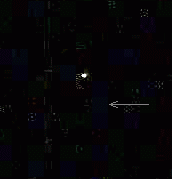
(This is a stretch of the three noise-subtracted M100 frames, presented at 100%, ie no zoom.)
A very rough back-of-the-envelope calculation shows that the separation is about right, and the second object is roughly in the ecliptic... ![]()
Posted by: fredk Feb 5 2014, 04:42 PM
Here's a stretched stack of the 2x zoomed, noise-subtracted M100 frames of the Earth:
And a view of Earth and Moon from Mars at the same time (but not the same orientation):
It looks like we may indeed be seeing the Moon! Can't wait to see the raw images...
Posted by: Ant103 Feb 5 2014, 04:56 PM
Here's a capture from Stellarium, sets on Mars exactly from the landing site, with a FOV roughly the same as the Mastcam100.
The Moon is in the right position.
Something else is bothering me. We should have seen Venus in the sky, just over the Gale Mountains (simulation here of the panoramic) :
Posted by: paraisosdelsistemasolar Feb 5 2014, 04:57 PM
Using the Fredk stacked version, I think we could agree that with a high degree of confidence, we are seeing our moon too:
Posted by: Ant103 Feb 5 2014, 05:26 PM
Here is what was I was able to do with the 3 frames showing the Earth. Indeed, the Moon is visible (after enhanced levels and some denoising).
Posted by: vikingmars Feb 6 2014, 12:41 PM
The pictures Curiosity took after sunset (Sol 529 at 18:47 pm local Martian time) showing the Earth as irs "Shepherd's" star are full of speckles, dots and rays, but the good amateur imaging specialists of the UMSF Forum did a good job in poipointing the Earth among all this "noise". This gave me the idea to reconstruct this "Earthset" picture from the panorama I built yesterday from Sol 530 pictures (see herewith a section of it, but much reduced and compressed to fit in the Forum). I carefully calibrated this afternoon panorama, so that it looks like what an astronaut would see from Mars and then fade it and darken it to reflect the luminosity felt after sunset and then match its hues with colouring data extracted from Viking lander and MER sunset pictures. I found the bluish halo above the setting Sun to be real, but the rest of the sky darkens with a pale peach like tint (not purple). Now, here you are on Mars watching our home world before and after sunset with those artistic reconstructions ! Also a tribute to Don Davis... Enjoy ! ![]()
Posted by: Ant103 Feb 6 2014, 02:13 PM
Great great GREAT Olivier ![]() I love it, especially the daylight panoramic
I love it, especially the daylight panoramic ![]()
(And you know where is coming from my obsession for open skies in my postcards ![]() ).
).
Posted by: Art Martin Feb 6 2014, 02:27 PM
Ok now here's the challenge. Is there software that would create a video out of those two images where it recreated the transitional frames between them as the sun sinks?
Posted by: fredk Feb 6 2014, 04:59 PM
Viking's beautiful mosaics prompted me to squeeze what I could out of the 529 night images to see what of the foreground is visible. Here's a comparison of one 529 noise-subtracted and heavily stretched frame with the corresponding day shot from 530. Indeed you can see that the Gale rim is brighter than the foreground, even this late in the evening:
Posted by: vikingmars Feb 6 2014, 06:34 PM
Dear Fredk : you are absolutely right ("Gale rim is brighter than the foreground, even this late in the evening") and this was naturally reflected when i did my processings for the"Earthset" pan.
=> Thanks also a lot Damia for your kind comments.
Posted by: Mr Valiant Feb 6 2014, 07:48 PM
I must reply to all the above posts.
Moderate me if you must, but I just want to say Wow!
No way I can contribute to the great science being done here on UMSF
at this time, but I want to say thankyou to our finest poster's.
Thankyou for the journey so far and well done.
Posted by: atomoid Feb 7 2014, 02:35 AM
I know there is at least one online image generator tool out there that does great interpolations between two images so that for instance, instead of a simple two-frame flicker-GIF, you can create a smooth transition composed of multiple interpolated frames that are intelligently composited for a great smooth (and not muddy) result. I have spent considerable energy trying to locate this but have come up empty handed.
I think someone in this same MSL thread posted one about a month or so ago, so hopefully they can chime in and point us in the right direction.
Posted by: fredk Feb 7 2014, 04:29 PM
The http://mars.jpl.nasa.gov/msl/multimedia/images/?ImageID=5968 points out that the moon should be easily visible to the unaided eye, something that hadn't occured to me before (or just forgot). Their maximum angular separation now is around 8', or just over 1/4 the diameter of the moon as seen from Earth. So even with the Earth being far brighter, I could believe that the moon would be discernable.
(Makes me wonder what the history of astronomy would've been like had we not needed to wait for Galileo to discover satellites around other planets with the telescope...)
Posted by: AndyG Feb 8 2014, 09:35 AM
My late father, whose eyesight was excellent (and considerably better than mine) stated he had seen, as a young man, Galilean satellites without optical aid. More on http://denisdutton.com/jupiter_moons.htm.
Andy
Posted by: scalbers Feb 8 2014, 07:32 PM
To partly address this I'm working on a panorama of the whole sky appearance as the sun goes down and a version (updated on Feb 11, 2014) can be seen here:
http://www.unmannedspaceflight.com/index.php?showtopic=6248&pid=206891&st=30&#entry206891
If a sequence like this can be fitted to the start and end images shown earlier, then the intermediate appearance of the sky could be visualized.
Posted by: Gerald Apr 23 2014, 01:28 PM
Two Sol 606 images, http://mars.jpl.nasa.gov/msl-raw-images/msss/00606/mcam/0606MR0025610100400979E01_DXXX.jpg and http://mars.jpl.nasa.gov/msl-raw-images/msss/00606/mcam/0606MR0025610090400978E01_DXXX.jpg, of Saturn, cleaned (intersect subtracted), 4x magnified, registered, summed, some dark gray subtracted, cropped:
Edit:
A Sol 606 Phobos image cleaned by the intersection used above, magnified 2x, brightness stretched a bit:
(The hot pixel artifact / black dot occurs when using the Phobos image for cleaning, too.)
Edit: A pair of Sol 606 MR
Longer exposure may have caused some motion blur.
(Edit: Corrected text, after Deimos' clarifying post about the order of aims, below.)
Posted by: Deimos Apr 24 2014, 11:29 PM
http://www.jpl.nasa.gov/news/news.php?release=2014-126
Posted by: dvandorn Apr 25 2014, 01:24 AM
Odd -- not only will the link not load, the main JPL website won't load, either. I'm getting good page loads pretty much everywhere else on the 'net, so I don't think it's my connection, here.
-the other Doug (with my shield, not yet upon it)
Posted by: Explorer1 Apr 25 2014, 01:45 AM
It's up now. Both of Dawn's destinations, plus a couple of outer planets to boot! With all this preparation, anticipations for October just keep growing...
Posted by: wildespace Apr 25 2014, 07:45 AM
My version of Phobos + Deimos image layering, using "difference" mode to exclude image noise:
Pixel-resized x4:
A bit unfortunate that Phobos intersected that hot pixel area the moment image was taken.
I am curious about the slightly greenish apeparance of Phobos in Mastcam images. Is it due to the atmospheric conditions, or the way camera operates?
Posted by: fredk Apr 25 2014, 02:24 PM
Check out the discussion of the greenish cast of mastcam images in the http://www.unmannedspaceflight.com/index.php?s=&showtopic=7418&view=findpost&p=208388
Posted by: Gerald Apr 25 2014, 05:08 PM
...
I'm not quite sure any more about the other object being Deimos, after the press release.
It's probably either Jupiter or Saturn, not quite sure which of the two.
Since there is a second object which easily survived the cleaning, registering, and stretching of the images, I'm pretty shure, that the two images (http://mars.jpl.nasa.gov/msl-raw-images/msss/00606/mcam/0606MR0025610040400973E01_DXXX.jpg, http://mars.jpl.nasa.gov/msl-raw-images/msss/00606/mcam/0606MR0025610050400974E01_DXXX.jpg) actually match.
Here the combined and enhanced version of the cleaned images:
Posted by: Gerald Apr 25 2014, 06:12 PM
http://mars.jpl.nasa.gov/msl-raw-images/msss/00606/mcam/0606ML0025610010301508E01_DXXX.jpg cleaned, combined and enhanced, using http://mars.jpl.nasa.gov/msl-raw-images/msss/00606/mcam/0606ML0025610020301509E01_DXXX.jpg:
http://imgur.com/uWF7IwP
The Phobos part is cropped of the cleaned first image.
Edit:
Similarly for Deimos, from http://mars.jpl.nasa.gov/msl-raw-images/msss/00606/mcam/0606ML0025610080301511E01_DXXX.jpg and http://mars.jpl.nasa.gov/msl-raw-images/msss/00606/mcam/0606ML0025610070301510E01_DXXX.jpg ML image:
http://imgur.com/HD28NOq
Posted by: Deimos Apr 25 2014, 06:22 PM
Looks like Jupiter to me. ![]() The aims appear to be Phobos-->Jupiter-->Deimos and friends-->Saturn-->Regulus.
The aims appear to be Phobos-->Jupiter-->Deimos and friends-->Saturn-->Regulus.
Posted by: Gerald Apr 25 2014, 08:57 PM
Thanks a lot! ![]()
From knowing, http://mars.jpl.nasa.gov/msl-raw-images/msss/00606/mcam/0606MR0025610120400981E01_DXXX.jpg and http://mars.jpl.nasa.gov/msl-raw-images/msss/00606/mcam/0606MR0025610110400980E01_DXXX.jpg image aiming to Regulus, at least two more stars can be identified:
(The raw images have been cleaned, combined, denoised, and enhanced over a couple of steps.)
Posted by: fredk Apr 26 2014, 12:40 AM
What do you mean by tau, Gerald? Are you saying that the glare around the sun or Phobos is an indication of tau? I'd've guessed that glare within the optical system was more important, at least for the low tau levels these days. If you compared with identical exposures at times of high tau maybe you'd see a difference in the glare?
Normally the brightness of the sun's disc is used as a measure of tau.
Posted by: Gerald Apr 26 2014, 02:27 AM
That's the direction I've been thinking. Part of the atmospheric opacity should be caused by scattering of light, not just by absorption. I'm presuming, that this could result in different halos or glares.
Posted by: mcaplinger Apr 26 2014, 04:22 AM
This recapitulates a discussion we've had within the imaging team. I tend to agree with Fred; we never characterized the Mastcams for stray light behavior at this kind of level.
I think you could do something with the sky brightness far enough away from the sun, and I believe that's part of the tau strategy. Phobos in the field, my guess is probably not.
Posted by: MarsInMyLifetime Apr 27 2014, 05:44 AM
Just a thought on another use for Gerald's image: Accumulation of dust on the front surface of the optics will be responsible for a significant part of this glare (isn't it actually flare?). If you can use the conventional measures of tau as a coefficient to factor out aerosol scattering contribution to the flare, the remaining component should be a relative indication of the dust accumulation.
Posted by: mcaplinger Apr 27 2014, 06:59 AM
I sure hope there isn't any dust on the optics; the cameras are stowed pointed down and are well off the surface, and the lenses are recessed several centimeters from the sunshade apertures.
Most in-field scattering is either from residual reflections off the AR coatings of the lenses or lens surface roughness.
Posted by: MarsInMyLifetime Apr 27 2014, 05:42 PM
Ah, in which case contributions from in-field scattering likely have been well characterized already. Thanks for the explanation.
Posted by: brellis Apr 27 2014, 11:11 PM
Is that one of the Mars moons over Mt. Sharp in Ant's Post #107?
Posted by: Deimos Apr 27 2014, 11:36 PM
I haven't looked at the raw image, but I'd say it is a cosmic ray. The moons cannot be in that direction, and it is broad daylight--they're faint. If one wanted to see them near the horizon, one would need to look at the left side of the mound or above the remarkable hill.
Posted by: fredk Apr 27 2014, 11:53 PM
Everything Deimos said, plus it's in the L nav but not the R nav.
http://mars.jpl.nasa.gov/msl-raw-images/proj/msl/redops/ods/surface/sol/00610/opgs/edr/ncam/NLB_451649637EDR_F0311330NCAM12813M_.JPG
http://mars.jpl.nasa.gov/msl-raw-images/proj/msl/redops/ods/surface/sol/00610/opgs/edr/ncam/NRB_451649637EDR_F0311330NCAM12813M_.JPG
Posted by: fredk Apr 28 2014, 03:24 PM
What a moon really looks like over the mountain:
http://mars.jpl.nasa.gov/msl-raw-images/proj/msl/redops/ods/surface/sol/00613/opgs/edr/ncam/NRB_451931834EDR_F0311330NCAM00554M_.JPG
And Phobos setting in the east:
Posted by: anticitizen2 Apr 28 2014, 04:07 PM
The 25 frames of sunset behind Remarkable on 610 are very subtle. I ditched the first frame which had overexposed parts
http://i.imgur.com/k1nPot8.gif
Here are the first and last frames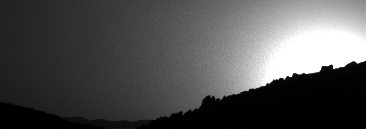
Edit: I think these are clouds to the upper left of the sun? Not really sure how to bring them out more
Edit2: http://i.imgur.com/JCaIOUP.gif
Posted by: paraisosdelsistemasolar Apr 28 2014, 05:23 PM
I tried to remove some of the noise of the moon-setting image.
Posted by: Gerald Apr 28 2014, 09:21 PM
Sol 613 moonset, (more or less) denoised, patched into the (denoised) full frame:
http://imgur.com/HFujjd9
Posted by: fredk Apr 29 2014, 04:42 PM
And Phobos set from M34:
http://mars.jpl.nasa.gov/msl-raw-images/msss/00613/mcam/0613ML0025880000301758E01_DXXX.jpg
Posted by: Phil Stooke May 3 2014, 03:01 PM
I was collecting the M-100 views of Phobos... are these the only ones so far or am I missing something? I'm not including images like the Aldebaran sequence where Phobos is not clearly visible.
Phil
Posted by: fredk May 3 2014, 03:31 PM
Apart from transits, the only other view I'm aware of was 474:
http://mars.jpl.nasa.gov/msl-raw-images/msss/00474/mcam/0474MR1886000000E1_DXXX.jpg
I'm not sure if this is the Aldebaran sequence you're talking about.
Posted by: Phil Stooke May 3 2014, 04:13 PM
Thanks! I forgot that one. The Aldebaran sequence was on sol 387, with Phobos all but invisible in the planet's shadow. It occulted the star.
Phil
Posted by: fredk May 7 2014, 01:51 AM
Moon egress from eclipse from navcam, sol 619:
I leave it as an exercise to determine which moon it is...
Posted by: James Sorenson May 7 2014, 06:45 AM
Only 7.01 degrees above the horizon explains the fade in, that would be Phobos. ![]()
https://flic.kr/p/nwu9mQ
Posted by: fredk May 7 2014, 02:12 PM
Yeah, that's evening in the west so can't be eclipse egress. Just Phobos doing what it likes to do, rise in the west.
Posted by: James Sorenson May 9 2014, 12:09 PM
The only stars that I can identify from whats down sofar in the Sol-619 M100 images. Star magnitudes are according to Starry Night.
https://flic.kr/p/ngodMt
Posted by: Gerald May 9 2014, 05:15 PM
Couldn't squeeze out more, either:
Edit:
Tentative identification of two 7.1 mag stars close to the background noise level, after enhancement of bright linear features parallel to the the apparent tracks of the stars:
http://imgur.com/6rs3krm
Posted by: brellis May 13 2014, 10:54 PM
This thread seems like an okay place to post a couple of questions that came to mind: in spite of their diminutive sizes, can Phobos and Deimos exert tidal force on Mars - perhaps when Phobos passes in front of Deimos? And, are there names equivalent to months or phases of our moon that are used for them? Thanks as always!
Brad
Posted by: Explorer1 May 13 2014, 11:03 PM
I found this:
http://adsabs.harvard.edu/abs/2003jsrs...13..131V
8% of one cm is not very impressive, as one might expect...
Posted by: Gerald Jun 1 2014, 09:45 PM
Image processed from two Sol 619 and two Sol 635 Mastcam Right "Regulus" images:
(Detected stars red, false positives yellow, stars at about the noise level green (magnitude about 7.5 to 8.0).)
Faintest detected star: HIP 50081, Magnitude 7.43 m.
Processing steps:
- Images have been cleaned by subtracting darkest pixels of respective pair,
- brightened 2-fold,
- rotated to make streaks representing stars vertical,
- applied linear operator with 5x7 kernel, all 5 matrix lines with relative weights (-1,-1,1,2,1,-1,-1), to average vertically and enhance vertical streaks at the same time,
- brightened 4-fold,
- registered by (small) rotation and translation, framed Sol 619 images to fit size,
- averaged each of the four possible triples out of four images (a weighted 1:1:2-average for technical, not for theoretical reasons),
- determined darkest pixel over four average images, to filter/average out bright noise/cr occurring in only one of the cleaned images.
For annotation and data reduction:
- blurring and contrast enhancement steps to simulate a more or less reasonable detection threshold to stay sensitive, but to avoid too many false positives,
- subtraction of two appropriate such images and appropriate enhancement returns lines around detected features.
- Additional annotation by using planetarium software (based on SIMBAD database), and Uranometria 2000.0 Deep Sky Atlas.
Errors are mine.
Animated excerpt of the procesing steps:
http://imgur.com/sstPlX3
Posted by: Gerald Jun 3 2014, 01:19 AM
This is now the four Sol 619/635 MR "Regulus" images processed to the heck, trying to squeeze out traces of even the faintest stars having left a couple of photons:
Some of the blibs aren't (pure) noise, but stars of the magnitude range between 7.5 and 8.0.
Even some stars in the range between magnitude 8 and 10 may be among the fainter blibs; some candidates are annotated in bluish color.
Thus, smart combination of a sequence of images taken under good observational conditions may allow to extend the sensitivity of MR to stars of magnitude 8.
Fainter stars are hardly to distinguish from noise, even after stacking a short sequence of images.
Might be, with an 8-images sequence mag 8.5 could become feasible for detection, but the effort - and the number of images needed (for a given exposure time) - grows exponentially with stellar magnitude.
Posted by: dvandorn Jun 3 2014, 07:11 AM
Maybe I'm really missing something, here, but... of what possible use is it (except for a certain "cool factor") to be able to separate out magnitude 7 and fainter stars from the noise in MSL nighttime images?
What scientific value can you get from MSL in terms of imaging faint stars that you can't get one huge heck of a lot easier (and far more cheaply) with other resources? You know, like going in the back yard with a pair of binoculars?
I guess I just don't understand the point of it. If I'm just being unenlightened, I apologize and am always receptive to further enlightenment... ![]()
-the other Doug (with my shield, not yet upon it)
Posted by: Explorer1 Jun 3 2014, 07:21 AM
I'd guess something could be learned about nighttime atmospheric conditions (tau, etc.), by measuring what stars are visible, as well as practicing for the Siding Spring flyby? Just off the topic of my head...
Posted by: nprev Jun 3 2014, 08:49 AM
I'd guess that the purpose here is at least threefold:
1- Determine the limiting magnitude of the optics for faint objects (and actually point sources in these examples)
2- Determine the clarity of the atmosphere, and possibly look for diurnal variances due to the 'atmospheric tide' & other factors
3- Last and obviously not least, characterizing the dark-sky performance of the optics to see what sorts of scientifically useful observations of Siding Springs are possible, if any. (Not to mention Kodak moments... ![]() )
)
Again, just my guesses here.
Posted by: djellison Jun 3 2014, 12:53 PM
Apart from the observations others have already mentioned, there's good words by Jim Bell on what they were looking at when doing similar observations with Spirit a long time ago.
http://marswatch.astro.cornell.edu/pancam_instrument/projects_2.html
Posted by: Gerald Jun 3 2014, 03:46 PM
My motivations to find out the limits of the information contents of the night images may roughly be summarized as follows:
- There has been a statement, IIRC, by Deimos, that the sensitivity of the Mastcams is near mag 7.5; I wanted to check this as independently as possible, and see how hard this limit is.
- What's better: More shortly exposed images or a lower number of longer exposed images?
- Which camera is more sensitive, MR or ML?
- Can we expect to observe the Siding Spring cometary nucleus? If so, together with the images of the orbital probes, we get precisely timed images from different angles resulting in high precision http://ssd.jpl.nasa.gov/?ephemerides. What's the best imaging technique? We should know before, not regret afterwards that we could have known before.
- Obtain and provide some insight/empathy/deeper understanding of the challenges and work of the MSL Science Team. You can only really appreciate their work, if you try to do it yourself every once in a while.
...And just "Curiosity" about what's hidden in those noisy images.
Posted by: mcaplinger Jun 3 2014, 04:51 PM
We already built the cameras and flew them to Mars, so the incremental cost of taking these images, even if they had no scientific utility at all, is not very high.
Posted by: xflare Jun 3 2014, 05:03 PM
Has a night time camera - one specifically designed for low light observations, night time atmospheric/astronomical ever been considered for a Mars Lander?
Posted by: fredk Jun 3 2014, 05:25 PM
I thought that the skies tend to be so dusty that it's not a great place to do serious astronomy. Also low light would presumably mean large aperture which means weight and cost. Then for astronomical observations you'd need a mount to track the moving stars which adds more weight and cost and be able to align the mount after a drive...
Posted by: mcaplinger Jun 3 2014, 06:27 PM
Not that I'm aware of, because there's no compelling science to be done by such a camera.
FWIW, there was a purpose-built optical navigation camera on MRO for technology demonstration.
Posted by: Deimos Jun 4 2014, 12:30 AM
Good questions, and there have been several good answers. I can fill in some specifics.
What scientific value can you get from MSL in terms of imaging faint stars that you can't get one huge heck of a lot easier (and far more cheaply) with other resources? You know, like going in the back yard with a pair of binoculars?
In terms of processing images that have already been taken, I certainly think it is cool to check here and see people bringing out faint stars. In terms of taking images with the specific objective of seeing such stars, that is mostly not worth it. There was (for ISON) and is (for Siding Springs) and expectation that the MSL team will make a best effort to see the comet. There were necessary images taken as tests to determine sensitivity (too little for ISON without a lot more activity) and the best way to maximize sensitivity. The MCAM detectors sure don't act like Pancam, so new lessons must be learned.
In terms of scientific value of night images, here are some recent purposes. Many of them are marginal: the resources are there, and every so often there are excess resources in all relevant areas (power, data, complexity of activity plan). The cost is not 1/669 of the MSL budget (or whatever), as no new resources are committed.
- Images with Regulus and other bright stars are about the bright stars. Luckily, there is nothing we can learn about them with MCAM--so we can use them to measure night time opacity (clouds, dust, whatever).
- Images with the moons have a few purposes. Night opacity is one. Positional astronomy of the moons is another -- that, AFAIK, is the one astronomical thing that can be done better from Mars than Earth. That is especially precise during a mutual event (transit, eclipse, lunar or stellar occultation, near miss of occultation). When a moon goes into eclipse, you can measure upper atmosphere structure. MCS does this better, but getting data for cross-checking things is not bad. The most recent images of Phobos in shadow were not about vertical structure, but I bet the purpose could be reverse-engineered.
- Images of the comet could include several things, but they depend on what the comet does between now and October.
- Images of sunset and/or twilight (or moon rise/set a couple times) are usually about dust vertical structure.
- Tests have included sensitivity and focus.
- Occasionally, images are taken because they might be cool. These are not so common, and many 'cool' images have one of the above purposes or represent a slight change to a sequence with a scientific purpose.
To respond to a different question: I like these activities, of course, but I wouldn't ever consider proposing a camera dedicated to astronomy from Mars. The cost would be quite high compared to the value. The only comparative advantage over Earth's surface would be in UV or in water bands--and space telescopes would be cheaper and better.
Posted by: jmknapp Jun 4 2014, 01:25 PM
Star-gazing the easy way:
http://curiosityrover.com/imgpoint.php?name=0647MR0023310040401925C00_DXXX
Posted by: dvandorn Jun 4 2014, 06:48 PM
OK, thanks for the replies. I guess a lot of it does come down to the "cool factor," plus engineering studies of the limits of the imaging systems plus low-light observations of Martian phenomena (aerial dust structuring, etc.).
I was simply struck by the question "why use MSL's cameras for functions for which they were not really designed?" But thanks for the explanations as to the motivations, they make a lot of sense.![]()
-the other Doug (with my shield, not yet upon it)
Posted by: Gerald Jun 6 2014, 10:59 PM
Sol 560 image combined (registered and averaged) of 16 MR images (2790 series), magnified 4-fold, and enhanced. It shows probably at least two active regions (associated with groups of sunspots) on the Sun:
Posted by: PaulH51 Jun 7 2014, 09:26 AM
Appears to tie in rather well with the actual situation as viewed from Earth... http://www.tesis.lebedev.ru/en/active_areas.html?m=6&d=7&y=2014
Posted by: fredk Jun 7 2014, 04:31 PM
The mastcam series was taken around 20:00 UT on June 4th. At the time we were about 28.5 degrees ahead of Mars in orbit. Using a synodic sun's rotation rate of 27.3 days means that we should see the same face of the sun roughly 2.2 days after the mastcam images were taken. That's around 1:00 UT June 7th. (Of course the sun's rotation is latitude-dependent so this time is necessarily ill-defined.)
The image on http://www.tesis.lebedev.ru/en/sun_pictures.html?m=6&d=6&y=2014 was taken at 23:36 on the 6th, which is pretty close. I don't see an obvious agreement, but it may be that mastcam was just able to resolve a couple of the largest groups.
Of course there's a rotation between these frames. Someone should be able to figure out the orientation of the mastcam frame using planetarium software or whatever and then we can see for sure if we're seeing real sunspots...
Posted by: fredk Jun 7 2014, 07:21 PM
http://www.tesis.lebedev.ru/en/sun_pictures.html?m=6&d=4&y=2014 was taken at very close to the same time as the mastcam series. It shows that of the four large groups visible in the view 2 days later that I linked to above, only two were prominent at the earlier time (the two rightmost on those images).
If you rotate the mastcam image by 118 degrees, you get pretty good agreement between the two mastcam spots and the two large groups on the later SDO image that were visible at the time of the mastcam shots:
The slight misalignment could be due to the time interval not being exactly right, uncertainty in the rotation rate at the relevant latitudes, and perhaps some equatorial latitude difference due to Mars's orbital inclination. The 118 degree rotation still needs to be confirmed.
Another approach would be to take the shot which was taken at about the same time as the mastcams, and transform it to the Mars view at that time knowing the angular viewpoint difference and direction.
Posted by: djellison Jun 10 2014, 09:45 PM
Didn't see that one coming at all - it was a Mercury transit..
http://www.jpl.nasa.gov/news/news.php?release=2014-183
Posted by: fredk Jun 10 2014, 11:45 PM
Very impressive. There's one more chance to observe a transit of Mercury next year and then a pause until 2023:
http://en.wikipedia.org/wiki/Transit_of_Mercury_from_Mars
Posted by: Explorer1 Jun 11 2014, 12:22 AM
And Venus in 2030. Curiosity might be around for that, but the 2020 rover certainly will be...
Posted by: Phil Stooke Jun 11 2014, 12:27 AM
The way things are going, Opportunity will be as well.
Phil
Posted by: Deimos Jun 11 2014, 03:22 PM
This transit was not observable for Opportunity, and was in-progress at sunrise for MSL. Last year's was during conjunction. Next year, it is in progress at sunset for MSL, and at sunrise for Opportunity (stereo!). Given 10x less contrast (from pixel size) for Pancam, I still am unconvinced we'd see a convincing detection worthy of the resources used. MSL could see both Mercury transits of the 2020s, and Opportunity can see neither.
On the other hand, Opportunity could see both Venus transits of the 2030s (2030 and 2032), and MSL neither. A Pancam- or M34-like instrument (with solar filters) on some other rover would be adequate.
Earth would be seen (followed a few hours later by the Moon, with a few hours of both) from MSL's site in 2084.
I'm not sure there would be further observations of Mercury transits, since we've gotten over the first-time observation ('because it is there'). But you never know. Resources lined up pretty nicely for this one. Obviously this was a luxury, and, in the spirit of the above discussion, was done for the cool factor--it would have been traded away in favor of driving or other key activities, if there had been anything important to gain.
Posted by: Gerald Jun 12 2014, 05:56 PM
Hard to put anything on top of a successful imaging of a Mercury transit, (coolness-factor). (I'm hoping for the comet. ![]() )
)
So here something totally profane (in comparison):
The last time I saw something similar was a Phobos eclipse; that's why I've posted it in this thread. One of two 5-image Sol 653 MAHLI sequences:
http://imgur.com/GVMYbeF
If I'm guessing right, this might have been the first such sequence with MAHLI.
(Edit: replaced sequence by one which should work.)
Posted by: fredk Jun 12 2014, 06:10 PM
Care to speculate what this sequence was about? Was there a Phobos transit at the time?
Posted by: Phil Stooke Jun 12 2014, 06:19 PM
Sky flats?
Phil
Posted by: Gerald Jun 12 2014, 06:47 PM
Thanks! This sounds plausible after checking the motor count. The values changed between images.
Posted by: marsophile Jun 12 2014, 07:53 PM
Parallax measurements of distances to stars, from different annual orbital positions, might potentially be improved by using the wider base of a Mars or outer planet orbit, but the tradeoff against the better sensitivity of Earth-based assets would probably more than counterbalance this factor.
Posted by: Gerald Jun 12 2014, 08:37 PM
A GAIA-like mission at a Lagrange-point of a planet further out might at least be worth to calc through. Certainly not realistic in short-term.
Posted by: fredk Jun 13 2014, 03:41 PM
The distance to which you'd get reliable parallaxes would scale linearly with the size of the orbit, so there's certainly room for improvement by moving farther out. But Kepler tells you that the orbital period scales like the 3/2 power of the orbit size, so the timescale for a mission grows faster than the improvement in distance. Of course if you consider volumes, then the timescale increases like only the square root of the volume you can measure parallaxes over, so it may appear to be to your advantage to move out.
But in practice, I'd guess the increased timescale would be a serious problem. Gaia is meant to survey for 5 years. So a comparable mission at Jupiter's orbit would need 60 years. It would probably be considerably cheaper to just scale up Gaia to 5 times the mirror diameter and keep it at Earth's L2, which would give you the same parallax reach as a Gaia-like Jupiter mission in 1/12th the time.
Posted by: Gerald Jun 13 2014, 08:31 PM
With more full surveys per orbit, and just one and a half full orbits you may be able to get the first set of good data within 18 years plus cruise and commissioning for the Jupiter case. Gaia is scheduled to need 18 months for the first set of calibrated data (see p. 13 of http://mpia.de/~dynamics/ringberg/files/brown.pdf). Well, that's still a lot of patience.
I'd think the main technical obstacle at the moment would be the transmission of the enormous amount (in the Petabyte order of magnitude) of data.
May be laser communication, and relais stations could do the job; but that's a lot of infrastructure.
Posted by: Gerald Jun 26 2014, 04:11 PM
Two of the Sol 662 Phobos images magnified x2, registered, summed, cropped:
Posted by: Phil Stooke Jun 26 2014, 04:57 PM
Beat me to it! The two smeared long exposure images catch a bit of Phobos illuminated by Mars reflected light. In this view the south polar crater Hall is at left.
Phil
Posted by: Gerald Jun 26 2014, 06:15 PM
Here the long-exposure Sol 662 Phobos images, processed in two different ways.
2-image gif, stars enhanced, fixed, images cleaned by each other:
http://imgur.com/YjWLHgI
2-image gif, camera fixed, image cleaned with a third image, trying to avoid subtracting away light scattering:
http://imgur.com/BxevpW9
single images, stars enhanced, fixed:
http://imgur.com/exSzua0 http://imgur.com/NDs1Vpl
single images, camera fixed:
http://imgur.com/Uyvq1kv http://imgur.com/yp6XzKM
To enhance stars, I've cleaned (subtracted darkest) and registered the images, then taken the darkest (kind of intersection) to subtract away Phobos, then enhanced stars; recombined (brightest, kind of union) result with the Phobos-showing cleaned and registered images.
Posted by: Gerald Jun 27 2014, 06:18 PM
Thanks to http://curiosityrover.com/synth/?camera=MR&station=196, Redshift 7 planetarium software, and the Uranometria 2000.0 Deep Sky Atlas, I've probably finally been able to identify a couple of stars in the Sol 662 Phobos images, stars strongly enhanced:
Visual magnitudes of the stars are between 3.04 and 6.50 m (HIP 50485), according to the above sources.
Posted by: anticitizen2 Aug 10 2014, 08:04 PM
Thumbnails of the Phobos transit
Posted by: Gerald Aug 21 2014, 10:42 AM
Sol 713 Phobos transit, eleven full-resolution images as animated gif:
Posted by: Gerald Aug 23 2014, 11:21 PM
Cleaned and enhanced Sol 727 EDR ChemCam image of Spica:
(The paler streak below the bright one is a ghost image.)
Preliminary hipass-cleaned RDR image of Regulus (Spica-image for cleaning not yet available as RDR):
http://imgur.com/L75OdLi
(Coordinates for identification by http://curiosityrover.com/synth/, lookup in Uranometria 2000.0 Deep Sky Atlas)
Posted by: Gerald Aug 25 2014, 12:09 AM
One of the Sol 727 ML nightshot pairs cleaned, rotated 8.43°, enhanced, annotated:
(used Joe's site, Uranometria, and Redshift 7 for identification of the stars)
Posted by: Gerald Aug 27 2014, 05:19 PM
Spotting the sunspots of the http://www.planetary.org/blogs/emily-lakdawalla/2014/08251427-curiosity-watches-phobos.html:
The image is combined (registered, averaged, "flatfield"-corrected for the disk of the Sun, 16x enhanced, more) from 2x16 of the 4x magnified transit images. It still contains remnants of jpg artifacts and pixelation.
Posted by: Gerald Sep 7 2014, 11:23 AM
Four combined and enhanced Sol 441 ChemCam RMI nightshots, derived from the enhanced PNGs:
http://imgur.com/yYJRlmb http://imgur.com/fHBuPpc http://imgur.com/99oQAPS http://imgur.com/yRvZZj8
Still contain vertically displaced ghost image.
Edit: By http://curiosityrover.com/synth/?camera=CC&station=238, and Uranometria 2000.0 Deep Sky Atlas I could identify the bright object as Vega.
Posted by: Phil Stooke Sep 7 2014, 04:02 PM
I'm waiting for RMI images of Phobos and Deimos. I was wondering if this was Deimos until you posted that.
Phil
Posted by: Gerald Sep 7 2014, 07:40 PM
You made me curious, how Deimos would look like with RMI.
According to http://www.lpi.usra.edu/meetings/lpsc2012/pdf/2541.pdf the fov of MR is 6.3° x 5.1°. MR images are usually 1344 pixels wide.
ChemCam has a fov of about 1.1° for 1024 pixels.
This translates to a factor of 6.3° * 1024 pixels / (1.1° * 1344 pixels) = 4.36 for the size of a pixel between RMI and MR.
Taking a crop of http://mars.jpl.nasa.gov/msl-raw-images/msss/00606/mcam/0606MR0025610070400976E01_DXXX.jpg of Deimos, and magnifying it by the factor of 4.36 returns an estimated image of Deimos for RMI of about this size (somewhere between 50 and 60 pixels diameter) :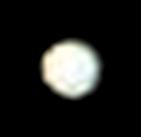
Maybe we've luck, and they'll make some pointing and timing tests with Phobos and Deimos to prepare the comet imaging; the comet should move faster than even Phobos.
Edit: With 1600 pixels width for the MR, the factor for the pixel sizes is about 3.67, making the image of Deimos 84% the size of the above simulated one (about 45 pixels diameter), to give an idea of the uncertainty of the above estimate.
Posted by: Deimos Sep 7 2014, 08:06 PM
The comet should not move across the sky faster than Phobos at a time it can be observed. Anytime that the comet is up and the sky is dark (for either rover) is hours from closest approach.
I'm not expecting lunar images with RMI anytime soon--it is risky at this season. There are many precautions taken to keep the RMI from being damaged by the Sun, including damage that could occur after (for instance) RSM motion becomes precluded mid-sequence for some reason. There are times of year that this is not a risk, but I think the risk may be peaking right around now.
Posted by: fredk Sep 7 2014, 08:59 PM
Remember that chemcam's psf is quite a bit wider than a pixel due to structural constraints - see eg http://msl-scicorner.jpl.nasa.gov/Instruments/ChemCam/ The actual resolution is something like 100 microrad, versus the pixel scale of around 19 microrad/pixel. So Deimos (the moon, not the poster) would look big, but not as sharp as with MR.
Posted by: nprev Sep 7 2014, 10:12 PM
MOD NOTE: Just a reminder that there's a thread for observations of the http://www.unmannedspaceflight.com/index.php?showtopic=7866 happening next month. Please try to put related posts over there in the interest of having a single-point repository of comments & work related to the event; thanks!
Posted by: Gerald Sep 8 2014, 12:16 PM
http://mars.jpl.nasa.gov/msl-raw-images/msss/00741/mcam/0741MR0031830000403289E01_DXXX.jpgs cleaned, combined, enhanced, annotated:
http://imgur.com/ju03dzI
Epsilon 1/2 Lyrae "http://en.wikipedia.org/wiki/Epsilon_Lyrae" is well separated in two stars; the two components are 3.47 arc minutes (0.05783°) separated; this should correspond to a separation of 13.6 pixels for MR (with 1200 pixels for 5.1°).
Posted by: Gerald Sep 8 2014, 03:21 PM
http://mars.jpl.nasa.gov/msl-raw-images/msss/00741/mcam/0741ML0031830000205646E01_DXXX.jpgs, cleaned, combined, enhanced, annotated:
http://imgur.com/EQx4ndX
Enhancement has been a little different from the MR enhancement, since the streaks are shorter in the ML images used here.
Epsilon Lyrae is separated in the ML images, as well.
The Sol 741 MastCam shots have been a bit tricky to combine, since they are taken about 13 minutes apart; therefore one of each pair needed to be rotated about 3.4 degrees to register.
To roughly locate the MR and ML images, I've used http://curiosityrover.com/synth/?camera=ML&station=238. For identification of the stars I relied mainly on Redshift 7 planetarium software.
Posted by: jmknapp Sep 29 2014, 11:03 AM
Given the right conditions, would a long mastcam R exposure show trails from sunlight reflecting off orbiting satellites like MRO, ODY, Maven, Mangalyaan, MGS, even Viking?
Posted by: djellison Sep 29 2014, 01:24 PM
Spirit successfully imaged Mars Odyssey with Pancam, so one would infer that yes, MastCam should be able to do the same.
Posted by: Phil Stooke Sep 29 2014, 02:07 PM
The Spirit observations were overnight on sols 653-654 and 660-661.
I had a note that they were unsuccessful on sol 660, but now I can't back that up either way. Do you know which sol was successful?
EDIT - never mind, I found your earlier post with the sol 661 animation. Very cool!
Phil
Posted by: fredk Sep 29 2014, 03:14 PM
(Sorry, this is off topic for MSL, but I'm not sure where else to post.)
The Spirit 661 observations in the gif by Doug I believe show a star. If you look elsewhere in the frames, you can see other point sources moving parallel to and at the same rate as the source in Doug's gif, which suggests they are all setting stars. Here I've pointed to a couple other point sources in addition to Doug's, which is the brightest:
Also, given the time interval between frames, the rate of motion agrees with stellar motion. I'd expect a satellite to have a considerably higher angular speed.
I haven't looked at the PDS - it might very well be that ODY is in there, but may take work to pull out. Has anyone heard official confirmation that ODY was spotted?
Posted by: Deimos Sep 29 2014, 06:58 PM
I haven't heard any official conformation. ![]()
According to my notes, the bright object setting in the west is Rigel. ODY, in polar orbit, would go S-N (l-r) across the bottom-middle of the frame. I have a note about a horizontal streak (likely cosmic ray), but I do not see it in a quick look. In any case, it was in the wrong position and the wrong length for ODY, and not seen in a second image. But I encourage people to have a look at PDS data, if interested, because I am fairly sure ODY is geometrically in one or more of those frames.
For the original question--yes, under the right conditions, an orbiter could be seen. But those conditions would include a specular reflection off a shiny surface, which is difficult to predict with sufficient accuracy with available data. I looked at recent MOI geometries, but those were definitely not the right conditions.
Posted by: jmknapp Sep 29 2014, 11:49 PM
Would there be a scientific interest in spotting one of the decommissioned orbiters like MGS or Viking to, say, determine the long term evolution of the last known orbits? Or maybe those kind of effects are already known to a high degree?
Posted by: mcaplinger Sep 30 2014, 03:41 AM
We have almost no idea where MGS or Viking are by now, so the chance of spotting them in a random search is nearly zero. We can't even see orbiters with certainty when we know exactly where they are. We couldn't find MGS with HiRISE right after it was lost.
Powered by Invision Power Board (http://www.invisionboard.com)
© Invision Power Services (http://www.invisionpower.com)

